Paul van Yperen's Blog, page 213
December 10, 2019
Tilde Kassay
Tilde Kassay, born Matilde Cassai (1887-1964), was an Italian silent film actress between 1915 and 1921. Most of her films are considered lost, but sometimes a wonder happens.
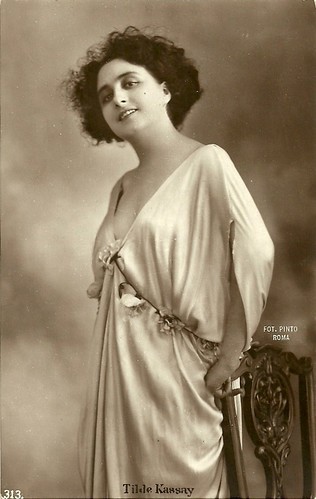
Italian postcard by Ed. A. Traldi, Milano, no. 313. Photo: Pinto, Rome.
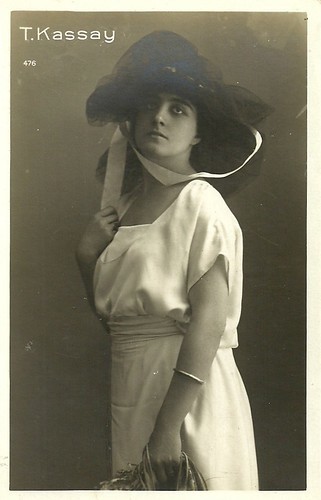
Italian postcard by Ed. G. Vettori, Bologna.
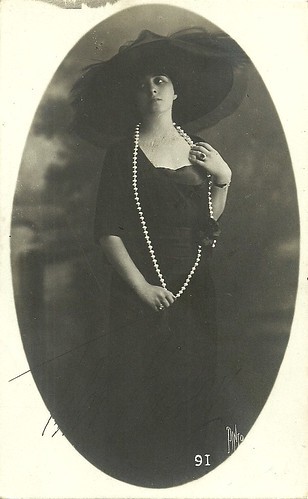
Italian postcard, no. 91. Ed. unknown. Photo: Pinto, Rome.
Directed by the greatest directors of the time
Born in Modena, Italy, in 1887, Matilde Kassay was the daughter of Massimiliano Cassai, and the third of four brothers and sisters: Anna, Caterina (known as Tina, also an actress), Matilde and Gaetano.
Tilde's film career took off in 1915 in Naples at the company Polifilms. Probably her first film was the war propaganda film Savoia, urrah!/Savoia, hurray! (Eduardo Bencivenga, 1915).
From 1917, Tilde Kassay acted at the Roman company Caesar Film. Between 1915 and 1921 she played in 17 films directed by the greatest directors of the time, in particular Camillo De Riso , Gustavo Serena , and Giulio Antamoro.
Of Kassay's films, Il cieco/The Blind Man (1919), directed by Edoardo Bencivenga, is preserved in the Archive of the Cineteca Nazionale in Rome. In this film, a husband ( Livio Pavanelli ), blinded during a hunting party, suspects that his wife (Kassay) has an affair with another man (Giovanni Schettini), who courts her.
The husband first wants to kill his rival, then decides to kill himself but makes a mistake, which returns him his sight and his beloved. While the press didn't like the supporting actors, Pavanelli and Kassay were praised.
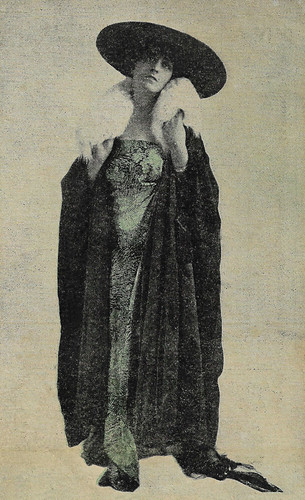
Spanish collectors card by Chocolat Imperial, no. 1 (in a series of 18 chromos). Photo: Caesar Film, distr. in Catalonia by J. Gurgui, Barcelona. Tilde Kassay in Una donna funesta/Nanà (Camillo De Riso, 1917-1919).
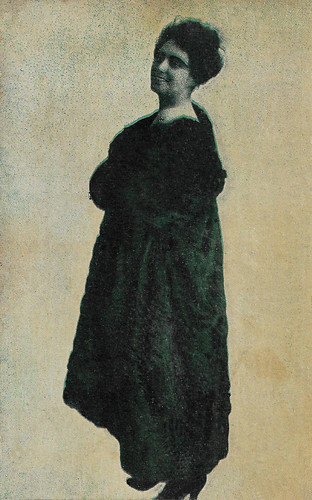
Spanish collectors card by Chocolat Imperial, no. 3 (in a series of 18 chromos). Photo: Caesar Film, distr. in Catalonia by J. Gurgui, Barcelona. Tilde Kassay in Una donna funesta/Nanà (Camillo De Riso, 1917-1919).
Considered only for adults
The other films with Tilde Kassay have probably gone lost. However, sometimes a wonder happens. In 2016 the film Una donna funesta/Nanà (1919), adapted from Emile Zola's classic novel 'Nanà' and presented abroad under the title of the novel, was rediscovered. The film, co-starring Camillo De Riso , Gustavo Serena , and Lido Manetti , was shown at the Giornate del Cinema Muto in Pordenone, Italy.
At its original release, the film had bad luck. Already in 1917 producer Barattolo and director Camillo De Riso had made the film, but just before the first night in Milan it was withdrawn from circulation as it was considered 'only for adults'. This caused a scandal and Barattolo had to withdraw the film.
He arranged a softened version, lifted any reference to Zola, and gave the film a happy ending instead of the original tragic ending of Nanà. Still, the Italian censor was not yet satisfied and demanded a series of cuts of too suggestive intertitles and images.
Eventually, the press criticised the now very free adaptation. Abroad, a much less censured version circulated, as Spanish collector cards of the film suggest. This is also confirmed in the found and restored version, from Buenos Aires, which is the 1917 version and not the censored 1919 version. The 1917 version is much closer to Zola's novel.
Kassay's last film was Diana Sorel (Gustavo Serena, 1921), in which she played the title role, opposite Gustavo Serena and others.
In Naples Kassay married Luigi DB Stolte (1885-1967), a business entrepreneur, among the founding members of the Naples Nautical Club. They had a son, who died prematurely.
Tilde Kassay passed away in Naples in 1964.
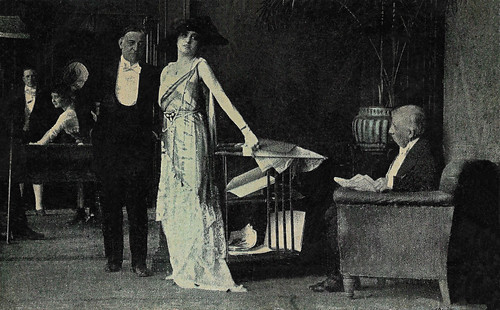
Spanish collectors card by Chocolat Imperial, no. 10 (in a series of 18 chromos). Photo: Caesar Film, distr. in Catalonia by J. Gurgui, Barcelona. Tilde Kassay in Una donna funesta/Nanà (Camillo De Riso, 1917-1919).
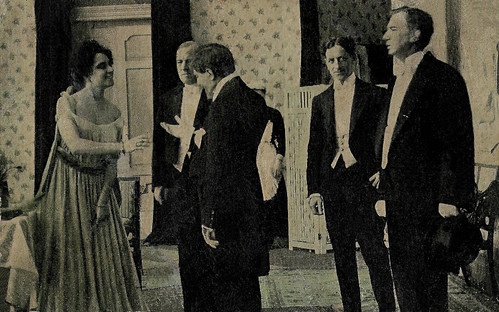
Spanish collectors card by Chocolat Imperial, no. 16 (in a series of 18 chromos). Photo: Caesar Film, distr. in Catalonia by J. Gurgui, Barcelona. Tilde Kassay in Una donna funesta/Nanà (Camillo De Riso, 1917-1919).
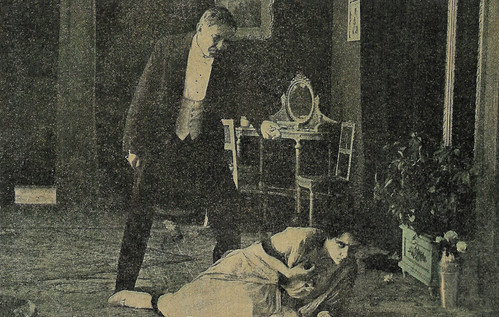
Spanish collectors card by Chocolat Imperial, no. 17 (in a series of 18 chromos). Photo: Caesar Film, distr. in Catalonia by J. Gurgui, Barcelona. Tilde Kassay in Una donna funesta/Nanà (Camillo De Riso, 1917-1919).
Sources: Wikipedia (Italian) and . Watch YouTube for the Pordenone screening of Nanà.

Italian postcard by Ed. A. Traldi, Milano, no. 313. Photo: Pinto, Rome.

Italian postcard by Ed. G. Vettori, Bologna.

Italian postcard, no. 91. Ed. unknown. Photo: Pinto, Rome.
Directed by the greatest directors of the time
Born in Modena, Italy, in 1887, Matilde Kassay was the daughter of Massimiliano Cassai, and the third of four brothers and sisters: Anna, Caterina (known as Tina, also an actress), Matilde and Gaetano.
Tilde's film career took off in 1915 in Naples at the company Polifilms. Probably her first film was the war propaganda film Savoia, urrah!/Savoia, hurray! (Eduardo Bencivenga, 1915).
From 1917, Tilde Kassay acted at the Roman company Caesar Film. Between 1915 and 1921 she played in 17 films directed by the greatest directors of the time, in particular Camillo De Riso , Gustavo Serena , and Giulio Antamoro.
Of Kassay's films, Il cieco/The Blind Man (1919), directed by Edoardo Bencivenga, is preserved in the Archive of the Cineteca Nazionale in Rome. In this film, a husband ( Livio Pavanelli ), blinded during a hunting party, suspects that his wife (Kassay) has an affair with another man (Giovanni Schettini), who courts her.
The husband first wants to kill his rival, then decides to kill himself but makes a mistake, which returns him his sight and his beloved. While the press didn't like the supporting actors, Pavanelli and Kassay were praised.

Spanish collectors card by Chocolat Imperial, no. 1 (in a series of 18 chromos). Photo: Caesar Film, distr. in Catalonia by J. Gurgui, Barcelona. Tilde Kassay in Una donna funesta/Nanà (Camillo De Riso, 1917-1919).

Spanish collectors card by Chocolat Imperial, no. 3 (in a series of 18 chromos). Photo: Caesar Film, distr. in Catalonia by J. Gurgui, Barcelona. Tilde Kassay in Una donna funesta/Nanà (Camillo De Riso, 1917-1919).
Considered only for adults
The other films with Tilde Kassay have probably gone lost. However, sometimes a wonder happens. In 2016 the film Una donna funesta/Nanà (1919), adapted from Emile Zola's classic novel 'Nanà' and presented abroad under the title of the novel, was rediscovered. The film, co-starring Camillo De Riso , Gustavo Serena , and Lido Manetti , was shown at the Giornate del Cinema Muto in Pordenone, Italy.
At its original release, the film had bad luck. Already in 1917 producer Barattolo and director Camillo De Riso had made the film, but just before the first night in Milan it was withdrawn from circulation as it was considered 'only for adults'. This caused a scandal and Barattolo had to withdraw the film.
He arranged a softened version, lifted any reference to Zola, and gave the film a happy ending instead of the original tragic ending of Nanà. Still, the Italian censor was not yet satisfied and demanded a series of cuts of too suggestive intertitles and images.
Eventually, the press criticised the now very free adaptation. Abroad, a much less censured version circulated, as Spanish collector cards of the film suggest. This is also confirmed in the found and restored version, from Buenos Aires, which is the 1917 version and not the censored 1919 version. The 1917 version is much closer to Zola's novel.
Kassay's last film was Diana Sorel (Gustavo Serena, 1921), in which she played the title role, opposite Gustavo Serena and others.
In Naples Kassay married Luigi DB Stolte (1885-1967), a business entrepreneur, among the founding members of the Naples Nautical Club. They had a son, who died prematurely.
Tilde Kassay passed away in Naples in 1964.

Spanish collectors card by Chocolat Imperial, no. 10 (in a series of 18 chromos). Photo: Caesar Film, distr. in Catalonia by J. Gurgui, Barcelona. Tilde Kassay in Una donna funesta/Nanà (Camillo De Riso, 1917-1919).

Spanish collectors card by Chocolat Imperial, no. 16 (in a series of 18 chromos). Photo: Caesar Film, distr. in Catalonia by J. Gurgui, Barcelona. Tilde Kassay in Una donna funesta/Nanà (Camillo De Riso, 1917-1919).

Spanish collectors card by Chocolat Imperial, no. 17 (in a series of 18 chromos). Photo: Caesar Film, distr. in Catalonia by J. Gurgui, Barcelona. Tilde Kassay in Una donna funesta/Nanà (Camillo De Riso, 1917-1919).
Sources: Wikipedia (Italian) and . Watch YouTube for the Pordenone screening of Nanà.
Published on December 10, 2019 22:00
December 9, 2019
Die grosse Pause (1927)
The German silent drama Die grosse Pause/The Long Intermission (Carl Froehlich, 1927) was another Henny Porten film, produced by her own production company Henny Porten-Froehlich Produktion GmbH. Fred Hildenbrandt and Walter Supper wrote the screenplay based on a play by Oskar Blumenthal and Max Bernstein. Walter Slezak and Livio Pavanelli were Porten's co-stars.
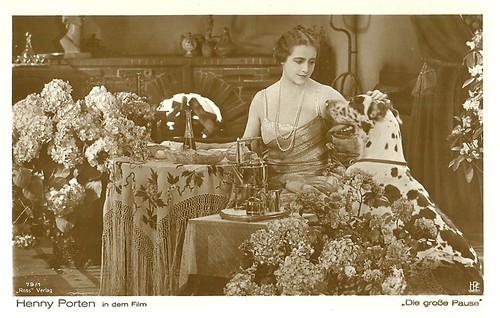
German postcard by Ross Verlag, no. 79/1. Photo: Henny Porten-Froehlich Produktion GmbH. Henny Porten in Die grosse Pause (Carl Froehlich, 1927).
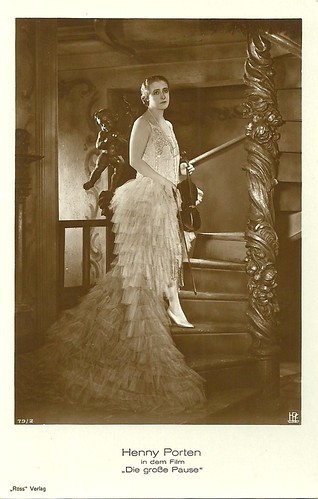
German postcard by Ross Verlag, no. 79/2. Photo: Henny Porten-Froehlich Produktion GmbH. Henny Porten in Die grosse Pause (Carl Froehlich, 1927).
Postillon d'amour
Henny Porten plays in Die grosse Pause/The Long Intermission (Carl Froehlich, 1927) Gabriele Amberg, a middle-aged violinist. She meets the much younger earl Ottokar Torgstädt ( Walter Slezak ). He is fascinated by her femininity and art, she by his youth. In addition, she feels flattered to be desired by the handsome nobleman.
So both marry abroad, without Ottokar's class-conscious family at home to hear about it. Count Ottokar does not want to confront Count and Countess Torgstädt with a fait accompli and presents them Gabriele in his native environment as his fiancee, his bride. But to be credible, the couple must first divorce again for that reason.
This 'big break' in marriage leads Gabriele to rethink. She realises that she and her Ottokar do not really fit together, because of the class difference, which raises all sorts of problems. Since Ottokar's cousin, Countess Ina Wildborn (Iwa Wanja), also smothers her ex-husband in an unrestrained way, Gabriele finds that the two, not only generation-wise, fit perfectly together.
So, she operates as a 'Postillon d'amour' and brings both together. Yet, the lucid violinist does not stay alone for long but finds new marriage happiness with her lawyer Boretius ( Livio Pavanelli ).
The film was shot at the Ufa studios in Tempelhof in May-June 1927 and had its premiere on 9 November 1927. Cinematography was by Axel Graatkjær. Sets were by Frantz Schroeder, costumes by Johanna Marbach.
Paimann's Filmlisten reviewed the film as "The age difference between the two spouses, which forms the basic motif of the subject, has been brought so much to the foreground by the choice of a young partner for Henny Porten , that almost the harmony of the film, which, moreover, has harmless-appealing, rich passages, and continuously well-staged action, suffers from it. Henny Porten is again excellent in general, while mise-en-scene and cinematography are neat."
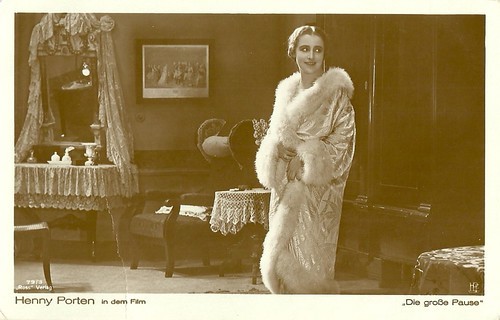
German postcard by Ross Verlag, no. 79/3. Photo: Henny Porten-Froehlich Produktion GmbH. Henny Porten in Die grosse Pause (Carl Froehlich, 1927).
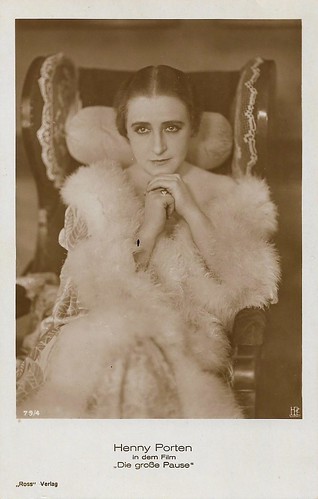
German postcard by Ross Verlag, no. 79/4. Photo: Henny Porten-Froehlich Produktion GmbH. Henny Porten in Die grosse Pause (Carl Froehlich, 1927).

German postcard by Ross Verlag, no. 79/5. Photo: Henny Porten-Froehlich Produktion GmbH. Henny Porten and Walter Slezak in Die grosse Pause (Carl Froehlich, 1927).
Sources: Filmportal.de, Wikipedia (German and English), and IMDb.

German postcard by Ross Verlag, no. 79/1. Photo: Henny Porten-Froehlich Produktion GmbH. Henny Porten in Die grosse Pause (Carl Froehlich, 1927).

German postcard by Ross Verlag, no. 79/2. Photo: Henny Porten-Froehlich Produktion GmbH. Henny Porten in Die grosse Pause (Carl Froehlich, 1927).
Postillon d'amour
Henny Porten plays in Die grosse Pause/The Long Intermission (Carl Froehlich, 1927) Gabriele Amberg, a middle-aged violinist. She meets the much younger earl Ottokar Torgstädt ( Walter Slezak ). He is fascinated by her femininity and art, she by his youth. In addition, she feels flattered to be desired by the handsome nobleman.
So both marry abroad, without Ottokar's class-conscious family at home to hear about it. Count Ottokar does not want to confront Count and Countess Torgstädt with a fait accompli and presents them Gabriele in his native environment as his fiancee, his bride. But to be credible, the couple must first divorce again for that reason.
This 'big break' in marriage leads Gabriele to rethink. She realises that she and her Ottokar do not really fit together, because of the class difference, which raises all sorts of problems. Since Ottokar's cousin, Countess Ina Wildborn (Iwa Wanja), also smothers her ex-husband in an unrestrained way, Gabriele finds that the two, not only generation-wise, fit perfectly together.
So, she operates as a 'Postillon d'amour' and brings both together. Yet, the lucid violinist does not stay alone for long but finds new marriage happiness with her lawyer Boretius ( Livio Pavanelli ).
The film was shot at the Ufa studios in Tempelhof in May-June 1927 and had its premiere on 9 November 1927. Cinematography was by Axel Graatkjær. Sets were by Frantz Schroeder, costumes by Johanna Marbach.
Paimann's Filmlisten reviewed the film as "The age difference between the two spouses, which forms the basic motif of the subject, has been brought so much to the foreground by the choice of a young partner for Henny Porten , that almost the harmony of the film, which, moreover, has harmless-appealing, rich passages, and continuously well-staged action, suffers from it. Henny Porten is again excellent in general, while mise-en-scene and cinematography are neat."

German postcard by Ross Verlag, no. 79/3. Photo: Henny Porten-Froehlich Produktion GmbH. Henny Porten in Die grosse Pause (Carl Froehlich, 1927).

German postcard by Ross Verlag, no. 79/4. Photo: Henny Porten-Froehlich Produktion GmbH. Henny Porten in Die grosse Pause (Carl Froehlich, 1927).

German postcard by Ross Verlag, no. 79/5. Photo: Henny Porten-Froehlich Produktion GmbH. Henny Porten and Walter Slezak in Die grosse Pause (Carl Froehlich, 1927).
Sources: Filmportal.de, Wikipedia (German and English), and IMDb.
Published on December 09, 2019 22:00
Triumph for The Favourite at the European Film Awards 2019
Yorgos Lanthimos’ The Favourite (2018) was the big winner at the European Film Awards, last Saturday 7 December 2019, winning eight prizes including best film, best director, best actress for Olivia Colman and best comedy. The scabrous depiction of the power struggle surrounding Queen Anne in the early 18th century, also won four previously announced technical awards for best cinematography, costume design, editing and hair and make-up.
THE FAVOURITE - European Film 2019. Source: European Film Awards (YouTube).
The healing power of art in difficult times
Antonio Banderas won best actor for his portrayal of an ailing director looking to his childhood for inspiration in Pedro Almodóvar’s Dolor y gloria/Pain and Glory (2019).
French film maker Céline Sciamma won best screenwriter for the ravishing lesbian period drama Portrait de la jeune fille en feu/A Portrait of a Lady on Fire (2019).
For Sama (2019), a riveting mum’s eye view on the siege of Aleppo by Waad al-Kateab and Edward Watts, took best documentary.
The Spanish/Dutch production Buñuel en el laberinto de las tortugas/Buñuel in the Labyrinth of the Turtles (Salvador Simó, 2018) won the best European Animated Feature Film 2019.
Werner Herzog was presented with the lifetime achievement award and Juliette Binoche received the European achievement in world cinema award. In a simple, touching speech she stressed the healing power of art in difficult times: “The world is not going well. But it feels like art is becoming more and more important. I think we have to be more truthful, more loving, better listeners.”
The three-hour ceremony, directed for the first time German filmmaker Dietrich Brüggemann and held at Berlin’s Haus der Festspiele, was marked by an emotional tribute to Nik Powell, film producer and the former chairman of the European Film Academy, who died unexpectedly last month.
Next year’s awards ceremony will take place in Reykjavik in Iceland.
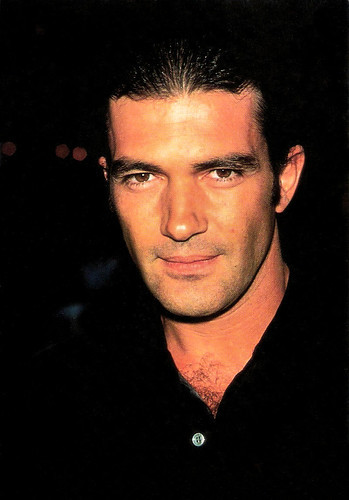
Italian postcard in the World Collection by Edibas s.r.l., Torino, no. P.c. 716. Photo: Olympia.
Last Saturday, 7 December 2019, Antonio Banderas (1960) won the European Film Award for Best Actor 2019 for his role in Dolor y gloria/Pain and Glory (Pedro Almodovar, 2019). The charismatic Spanish film actor, director, producer and singer began his acting career at age 19 with a series of films by director Pedro Almodóvar. He became an internationally known Latin heartthrob with high-profile Hollywood films including Philadelphia (1993), Interview with the Vampire (1994), Desperado (1995), Evita (1996), The Mask of Zorro (1998), and the Shrek sequels.
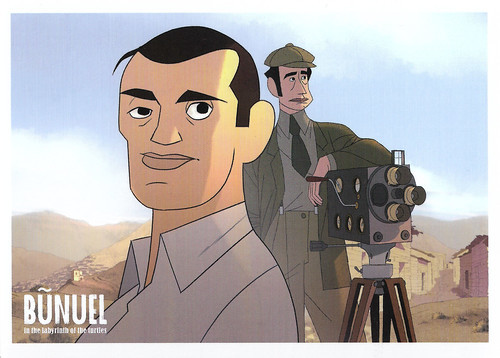
Dutch postcard by Periscoopfilm. Image: still for Buñuel en el laberinto de las tortugas/Buñuel in the Labyrinth of the Turtles (Salvador Simó, 2018). (A little mistake in the title of the postcard is that the accent on the u should be on the n, Buñuel).
Buñuel en el laberinto de las tortugas/Buñuel in the Labyrinth of the Turtles (Salvador Simó, 2018) is based on the graphic novel 'Buñuel in the Labyrinth of the Turtles'. Paris, 1930. Salvador Dalí and Luis Buñuel are already the main figures of the Surrealist movement. Unexpectedly, Buñuel is left moneyless after the scandal surrounding his film L'âge d'or/The Golden Age (1930). In this difficult situation, he cannot even tackle his next project, a documentary about one of the poorest Spanish regions, Las Hurdes. However, his good friend, sculptor Ramón Acín, buys a lottery ticket with the promise that, if he wins, he will pay for the film. Incredibly, luck is on their side.

Swiss postcard by News Productions, Baulmes, no. 55126. Photo: Bettina Rheims / Musée de l'Elysée, Lausanne, Switzerland. Caption: Juliette Binoche au bas filé (Juliette Binoche at the bottom spun), Garches, 1988.
French actress Juliette Binoche (1964) was honoured with the European Achievement in World Cinema award. Binoche has appeared in nearly 70 international films. She won numerous international awards, and has appeared on stage across the world. André Téchiné made her a star in France with the leading role in his drama Rendez-vous (1985). Her sensual performance in The Unbearable Lightness of Being (Philip Kaufman, 1988) launched her international career. Other career highlights are her roles in Three Colors: Blue (Krzysztof Kieślowski, 1993), The English Patient (Anthony Minghella, 1996), for which she won an Oscar, and Caché (Michael Haneke, 2005).
Official trailer for The Favourite (2018). Source: Fox Searchlight (YouTube).
Sources: Phil Hoad (The Guardian), Martin Blaney (Screen Dailey), EFA - The 32nd European Film Awards, and IMDb.
THE FAVOURITE - European Film 2019. Source: European Film Awards (YouTube).
The healing power of art in difficult times
Antonio Banderas won best actor for his portrayal of an ailing director looking to his childhood for inspiration in Pedro Almodóvar’s Dolor y gloria/Pain and Glory (2019).
French film maker Céline Sciamma won best screenwriter for the ravishing lesbian period drama Portrait de la jeune fille en feu/A Portrait of a Lady on Fire (2019).
For Sama (2019), a riveting mum’s eye view on the siege of Aleppo by Waad al-Kateab and Edward Watts, took best documentary.
The Spanish/Dutch production Buñuel en el laberinto de las tortugas/Buñuel in the Labyrinth of the Turtles (Salvador Simó, 2018) won the best European Animated Feature Film 2019.
Werner Herzog was presented with the lifetime achievement award and Juliette Binoche received the European achievement in world cinema award. In a simple, touching speech she stressed the healing power of art in difficult times: “The world is not going well. But it feels like art is becoming more and more important. I think we have to be more truthful, more loving, better listeners.”
The three-hour ceremony, directed for the first time German filmmaker Dietrich Brüggemann and held at Berlin’s Haus der Festspiele, was marked by an emotional tribute to Nik Powell, film producer and the former chairman of the European Film Academy, who died unexpectedly last month.
Next year’s awards ceremony will take place in Reykjavik in Iceland.

Italian postcard in the World Collection by Edibas s.r.l., Torino, no. P.c. 716. Photo: Olympia.
Last Saturday, 7 December 2019, Antonio Banderas (1960) won the European Film Award for Best Actor 2019 for his role in Dolor y gloria/Pain and Glory (Pedro Almodovar, 2019). The charismatic Spanish film actor, director, producer and singer began his acting career at age 19 with a series of films by director Pedro Almodóvar. He became an internationally known Latin heartthrob with high-profile Hollywood films including Philadelphia (1993), Interview with the Vampire (1994), Desperado (1995), Evita (1996), The Mask of Zorro (1998), and the Shrek sequels.

Dutch postcard by Periscoopfilm. Image: still for Buñuel en el laberinto de las tortugas/Buñuel in the Labyrinth of the Turtles (Salvador Simó, 2018). (A little mistake in the title of the postcard is that the accent on the u should be on the n, Buñuel).
Buñuel en el laberinto de las tortugas/Buñuel in the Labyrinth of the Turtles (Salvador Simó, 2018) is based on the graphic novel 'Buñuel in the Labyrinth of the Turtles'. Paris, 1930. Salvador Dalí and Luis Buñuel are already the main figures of the Surrealist movement. Unexpectedly, Buñuel is left moneyless after the scandal surrounding his film L'âge d'or/The Golden Age (1930). In this difficult situation, he cannot even tackle his next project, a documentary about one of the poorest Spanish regions, Las Hurdes. However, his good friend, sculptor Ramón Acín, buys a lottery ticket with the promise that, if he wins, he will pay for the film. Incredibly, luck is on their side.

Swiss postcard by News Productions, Baulmes, no. 55126. Photo: Bettina Rheims / Musée de l'Elysée, Lausanne, Switzerland. Caption: Juliette Binoche au bas filé (Juliette Binoche at the bottom spun), Garches, 1988.
French actress Juliette Binoche (1964) was honoured with the European Achievement in World Cinema award. Binoche has appeared in nearly 70 international films. She won numerous international awards, and has appeared on stage across the world. André Téchiné made her a star in France with the leading role in his drama Rendez-vous (1985). Her sensual performance in The Unbearable Lightness of Being (Philip Kaufman, 1988) launched her international career. Other career highlights are her roles in Three Colors: Blue (Krzysztof Kieślowski, 1993), The English Patient (Anthony Minghella, 1996), for which she won an Oscar, and Caché (Michael Haneke, 2005).
Official trailer for The Favourite (2018). Source: Fox Searchlight (YouTube).
Sources: Phil Hoad (The Guardian), Martin Blaney (Screen Dailey), EFA - The 32nd European Film Awards, and IMDb.
Published on December 09, 2019 04:17
December 8, 2019
Franz Lederer
Dark and gorgeous looking actor Franz Lederer (1899–2000) had a successful film and stage career, first in Europe, then in the United States as Francis Lederer.
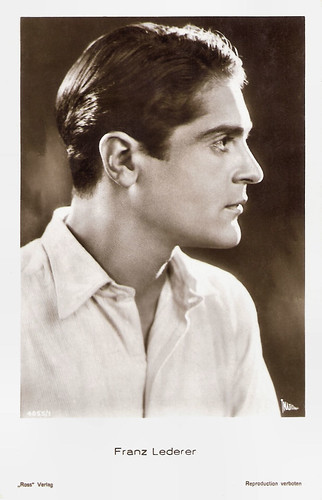
German postcard by Ross Verlag, no. 4055/1, 1929-1930. Photo: National.
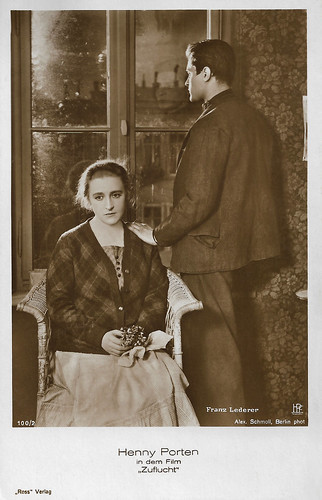
German postcard by Ross Verlag, no. 100/2. Photo: Alex. Schmoll / HPF (Henny Porten Film). Henny Porten and Franz Lederer in Zuflucht/Refuge (Carl Froelich, 1928).
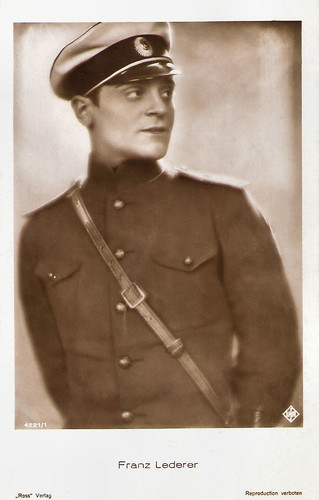
German postcard by Ross Verlag, no. 4221/1, 1929-1930. Photo: Ufa. Franz Lederer in Die wunderbare Lüge der Nina Petrowna/The Wonderful Lies of Nina Petrovna (Hanns Schwarz, 1929).
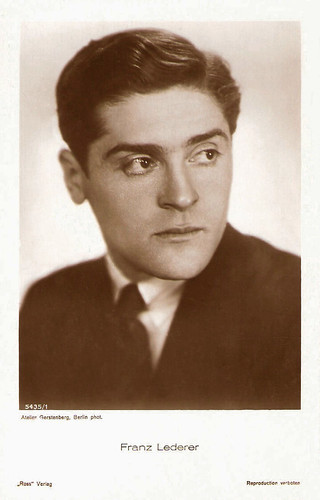
German postcard by Ross Verlag, no. 5435/1, 1930-1931. Photo: Atelier Gerstenburg, Berlin.
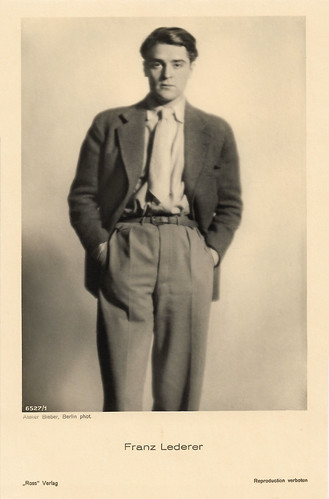
German postcard by Ross Verlag, no. 6527/1, 1931-1932. Photo: Bieber, Berlin.
Matinee Idol
Franz Lederer was born Frantisek Lederer in Prague, Austria-Hungary (now in Czech Republic) in 1899. He was the son of Josef Lederer, a leather merchant and Rose Lederer.
Young Frantisek began his working life as a department store delivery boy in Prague and fell in love with acting when he was young, and was trained at the Academy of Music and Academy of Dramatic Art in Prague.
Still a teenager, he served with the Czechoslovakian artillery during the first World War. He attained the rank of corporal. After military service, he became an apprentice with the New German Theatre in Prague.
He made his stage debut with a walk-on in the play Burning Heart. He toured Moravia and central Europe, making a name for himself as a matinee idol in theatres in Czechoslovakia, Hungary, Austria and Germany.
Because of his stunningly handsome looks, it took some time for the critics to take Lederer seriously. Notable among his performances was a turn as Romeo in theatre legend Max Reinhardt's staging of Romeo and Juliet.
In the late 1920s, Franz Lederer was lured into films by the German actress Henny Porten and her producer husband. He appeared with her in the melodrama Zuflucht/Refuge (Carl Froelich, 1928).
For director Georg Wilhelm Pabst he performed in Die Büchse der Pandora/Pandora's Box (G.W. Pabst, 1929) as a young man who, along with his father ( Fritz Kortner ), becomes obsessed with the hauntingly beautiful dancer Lulu ( Louise Brooks ).
He also appeared in Atlantik/Atlantic (Ewald André Dupont, 1929). Dashingly garbed in military costume, he was also notable in the lush and poignant romantic drama Die wunderbare Lüge der Nina Petrowna/The Wonderful Lie of Nina Petrovna (Hanns Schwarz, 1929) with Brigitte Helm .
Franz Lederer easily made the transition from silent to sound film, and seemed to be on his way to becoming one of Europe's top male film stars.
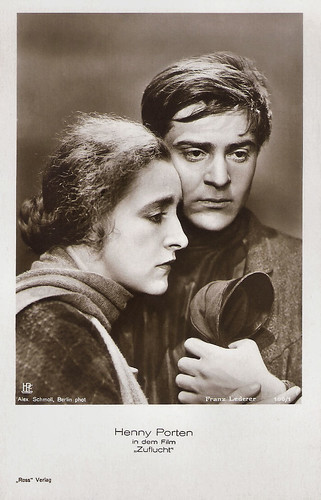
German postcard by Ross Verlag, no. 100/1. Photo: Alex. Schmoll / HPF (Henny Porten Film) Henny Porten and Franz Lederer in Zuflucht/Refuge (Carl Froelich, 1928).
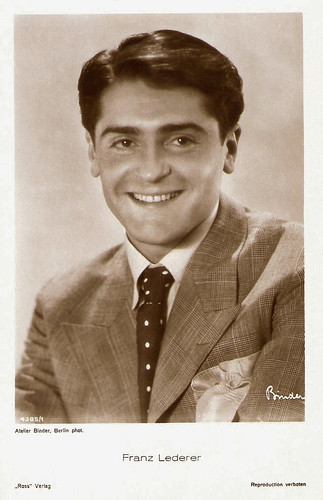
German postcard by Ross Verlag, no. 4385/1, 1929-1930. Photo: Atelier Binder, Berlin.
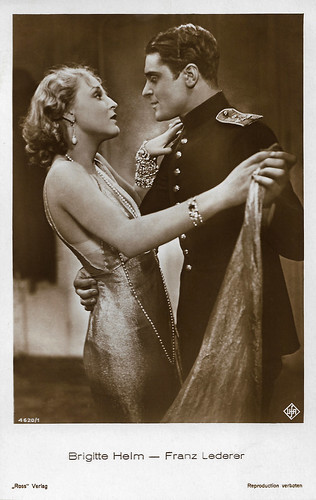
German postcard by Ross Verlag, no. 4620/1, 1929-1930. Photo: Ufa. Brigitte Helm and Franz Lederer in Die wunderbare Lüge der Nina Petrowna/ The Wonderful Lies of Nina Petrovna (Hanns Schwarz, 1929).
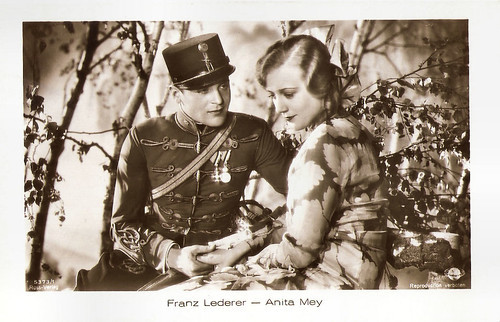
German postcard by Ross Verlag, no. 5373/1, 1930-1931. Franz Lederer and Anita Mey in an unidentified film.
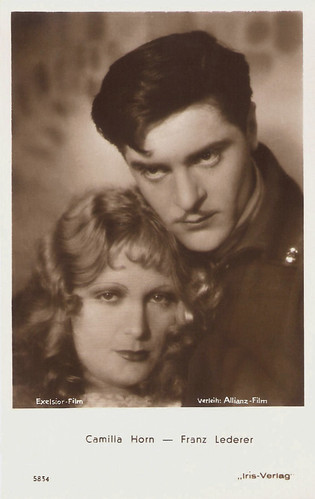
Austrian postcard by Iris-Verlag, no. 5834. Photo: Exelsior-Film / Allianz-Film. Franz Lederer and Camilla Horn in Fundvogel/Paradise Bird (Wolfgang Hoffmann-Harnisch, 1930).
The Biggest Star In Hollywood
In London’s West End, Francis Lederer performed on stage in Volpone (1931) and in Autumn Crocus (1932). He performed the latter play also on Broadway where it played for 210 performances in 1932 and 1933. He used Francis Lederer as his stage name now.
He also performed Autumn Crocus in Los Angeles, where his performances attracted film offers from Hollywood. With the deteriorating political situation in Europe, Lederer decided to stay in the United States.
It was MGM producer Irving Thalberg's plan to make him ‘the biggest star in Hollywood’ but the death of Thalberg ended that, and Lederer didn't quite catch on as an American star.
Lederer's American movies were fairly light fare such as Man of Two Worlds (J. Walter Ruben, 1934) with Elissa Landi , Romance in Manhattan (Stephen Roberts, 1934) with Ginger Rogers, The Gay Deception (William Wyler, 1935) with Frances Dee, and One Rainy Afternoon (Rowland V. Lee, 1936).
Lederer became a U.S. citizen in 1939. That year he starred as a lady-killer playboy in the Billy Wilder scripted Midnight (Mitchell Leisen, 1939) with Claudette Colbert and John Barrymore.
Hal Erickson writes at AllMovie : “His cinematic stock in trade at the time was the outgoing, slightly naïve foreigner at the mercy of aggressive, acrimonious Americans or Brits. One of his best screen characterizations was the disgruntled German-American ‘bundist’ in Confessions of a Nazi Spy (Anatole Litvak, 1939), which won him the personal praise of his co-star Edward G. Robinson , who wasn't accustomed to handing out empty compliments.”
He also earned plaudits for his portrayal of the fascist to whom Joan Bennett finds herself wed in The Man I Married (Irving Pichel, 1940).
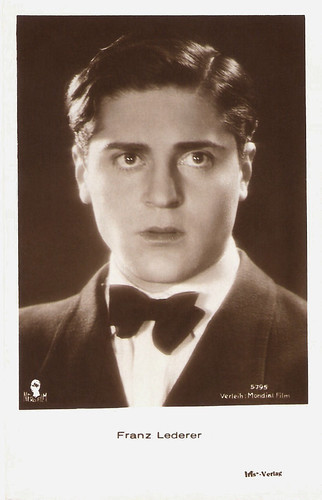
Austrian postcard by Iris-Verlag, no. 5795. Photo: Nero Film, Mondial Film.
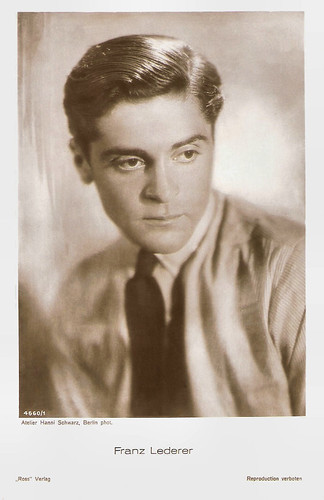
German postcard by Ross Verlag, no. 4660/1, 1929-1930. Photo: Hanni Schwarz.
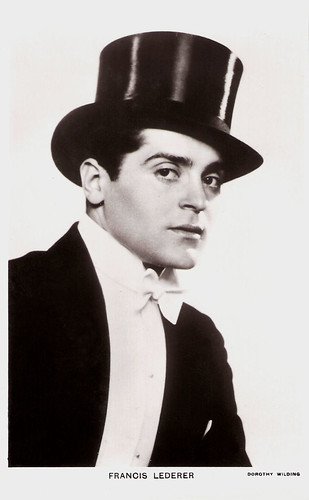
British postcard in the Picturegoer series, London no. 763. Photo: Dorothy Wilding.
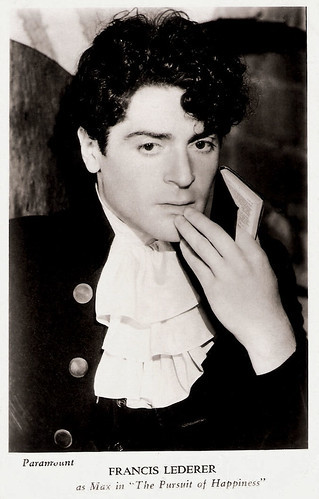
British postcard. Photo: Paramount. Publicity still for The Pursuit of Happiness (Alexander Hall, 1934).
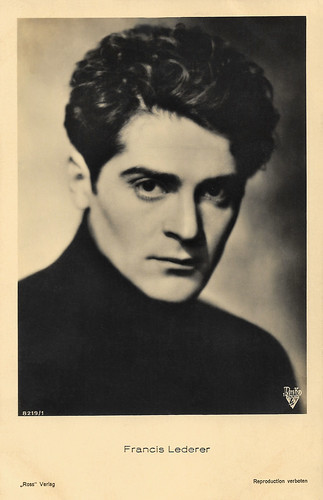
German postcard by Ross Verlag, no. 8219/1, 1933-1934. Photo: Radio Pictures.
A World Weary Count Dracula
Throughout his career, Francis Lederer often performed on stage, both in New York and elsewhere. He appeared in productions of Golden Boy (1937), Seventh Heaven (1939), No Time for Comedy (1939), in which he replaced Laurence Olivier , The Play's the Thing (1942), A Doll's House (1944), Arms and the Man (1950), The Sleeping Prince (1956) and The Diary of Anne Frank (1958) as Anne’s father.
Although he took a break from making films in 1941 in order to concentrate on his stage work, he returned to the silver screen in 1944, appearing in The Bridge of San Luis Rey (Rowland V. Lee, 1944), and the bizarre and fascinating version of the downbeat satirical drama Diary of a Chambermaid (Jean Renoir, 1946).
After making Surrender (Allan Dwan, 1950), he took another break from Hollywood but returned once more in 1956 with Lisbon (Ray Milland, 1956). He also played a world weary Count Dracula for The Return of Dracula (Paul Landres, 1958).
Cavett Binion at AllMovie reviews: “Played refreshingly straight, this modest Universal production benefits from Lederer's compelling performance as the seductive Count and several unique plot twists (including a blind girl who becomes sighted on turning into a vampire).”
His final film appearance was in Terror Is a Man (Gerardo de Leon, 1959). He would continue to make television appearances for the next ten years in such shows as The Untouchables (1960), Mission: Impossible (1967) and That Girl (1967).
His final television appearance occurred in a 1971 episode of Rod Serling's Night Gallery. Lederer had become very wealthy by investing in real estate. He was active in local and Los Angeles civic affairs, philanthropy and politics. In 2000, he was honoured with the Cross of Honor for Science and Arts, First Class by the Austrian government.
Lederer married three times. His first marriage was to Ada Nejedly during the 1920s. In 1937 he married Mexican American actress and dancer Margo. They divorced in 1940. His third marriage was to Marion Irvine in 1941. Irvine served as Los Angeles' Commissioner of Cultural Affairs. Their marriage lasted 59 years.
Francis Lederer worked as a teacher up until the week before he died in Palm Springs, USA in 2000. He was 100.
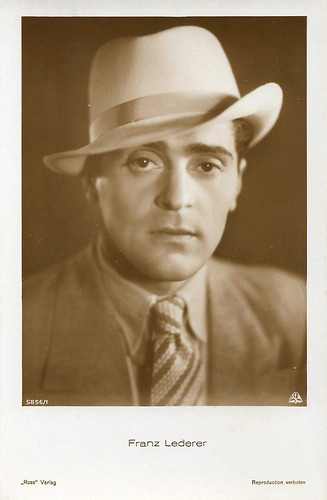
German postcard by Ross Verlag, no. 5856/1. 1930-1931. Photo: Aafa Film.
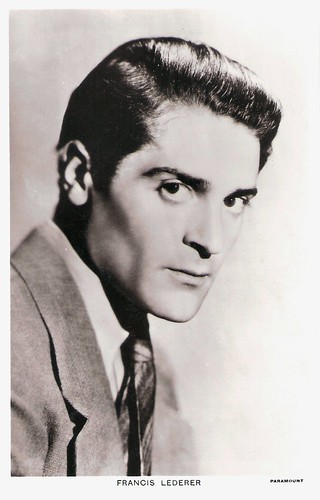
British postcard by Real Photograph, no. 763a. Photo: Paramount.

British postcard in the Picturegoer series, London no. 763b. Photo: United Artists.
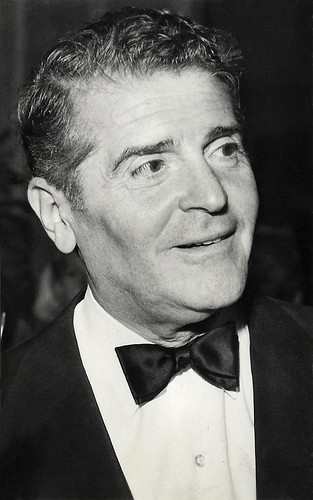
Small Czech collectors card by Pressfoto, Praha (Prague), no. S 56/9, 1964.
Scene from Die wunderbare Lüge der Nina Petrowna/The Wonderful Lie of Nina Petrovna (1929). Source: Radio Santos (YouTube).
Sources: Hal Erickson (AllMovie), Cavett Binion (AllMovie), (IMDb), TCM, Wikipedia and .

German postcard by Ross Verlag, no. 4055/1, 1929-1930. Photo: National.

German postcard by Ross Verlag, no. 100/2. Photo: Alex. Schmoll / HPF (Henny Porten Film). Henny Porten and Franz Lederer in Zuflucht/Refuge (Carl Froelich, 1928).

German postcard by Ross Verlag, no. 4221/1, 1929-1930. Photo: Ufa. Franz Lederer in Die wunderbare Lüge der Nina Petrowna/The Wonderful Lies of Nina Petrovna (Hanns Schwarz, 1929).

German postcard by Ross Verlag, no. 5435/1, 1930-1931. Photo: Atelier Gerstenburg, Berlin.

German postcard by Ross Verlag, no. 6527/1, 1931-1932. Photo: Bieber, Berlin.
Matinee Idol
Franz Lederer was born Frantisek Lederer in Prague, Austria-Hungary (now in Czech Republic) in 1899. He was the son of Josef Lederer, a leather merchant and Rose Lederer.
Young Frantisek began his working life as a department store delivery boy in Prague and fell in love with acting when he was young, and was trained at the Academy of Music and Academy of Dramatic Art in Prague.
Still a teenager, he served with the Czechoslovakian artillery during the first World War. He attained the rank of corporal. After military service, he became an apprentice with the New German Theatre in Prague.
He made his stage debut with a walk-on in the play Burning Heart. He toured Moravia and central Europe, making a name for himself as a matinee idol in theatres in Czechoslovakia, Hungary, Austria and Germany.
Because of his stunningly handsome looks, it took some time for the critics to take Lederer seriously. Notable among his performances was a turn as Romeo in theatre legend Max Reinhardt's staging of Romeo and Juliet.
In the late 1920s, Franz Lederer was lured into films by the German actress Henny Porten and her producer husband. He appeared with her in the melodrama Zuflucht/Refuge (Carl Froelich, 1928).
For director Georg Wilhelm Pabst he performed in Die Büchse der Pandora/Pandora's Box (G.W. Pabst, 1929) as a young man who, along with his father ( Fritz Kortner ), becomes obsessed with the hauntingly beautiful dancer Lulu ( Louise Brooks ).
He also appeared in Atlantik/Atlantic (Ewald André Dupont, 1929). Dashingly garbed in military costume, he was also notable in the lush and poignant romantic drama Die wunderbare Lüge der Nina Petrowna/The Wonderful Lie of Nina Petrovna (Hanns Schwarz, 1929) with Brigitte Helm .
Franz Lederer easily made the transition from silent to sound film, and seemed to be on his way to becoming one of Europe's top male film stars.

German postcard by Ross Verlag, no. 100/1. Photo: Alex. Schmoll / HPF (Henny Porten Film) Henny Porten and Franz Lederer in Zuflucht/Refuge (Carl Froelich, 1928).

German postcard by Ross Verlag, no. 4385/1, 1929-1930. Photo: Atelier Binder, Berlin.

German postcard by Ross Verlag, no. 4620/1, 1929-1930. Photo: Ufa. Brigitte Helm and Franz Lederer in Die wunderbare Lüge der Nina Petrowna/ The Wonderful Lies of Nina Petrovna (Hanns Schwarz, 1929).

German postcard by Ross Verlag, no. 5373/1, 1930-1931. Franz Lederer and Anita Mey in an unidentified film.

Austrian postcard by Iris-Verlag, no. 5834. Photo: Exelsior-Film / Allianz-Film. Franz Lederer and Camilla Horn in Fundvogel/Paradise Bird (Wolfgang Hoffmann-Harnisch, 1930).
The Biggest Star In Hollywood
In London’s West End, Francis Lederer performed on stage in Volpone (1931) and in Autumn Crocus (1932). He performed the latter play also on Broadway where it played for 210 performances in 1932 and 1933. He used Francis Lederer as his stage name now.
He also performed Autumn Crocus in Los Angeles, where his performances attracted film offers from Hollywood. With the deteriorating political situation in Europe, Lederer decided to stay in the United States.
It was MGM producer Irving Thalberg's plan to make him ‘the biggest star in Hollywood’ but the death of Thalberg ended that, and Lederer didn't quite catch on as an American star.
Lederer's American movies were fairly light fare such as Man of Two Worlds (J. Walter Ruben, 1934) with Elissa Landi , Romance in Manhattan (Stephen Roberts, 1934) with Ginger Rogers, The Gay Deception (William Wyler, 1935) with Frances Dee, and One Rainy Afternoon (Rowland V. Lee, 1936).
Lederer became a U.S. citizen in 1939. That year he starred as a lady-killer playboy in the Billy Wilder scripted Midnight (Mitchell Leisen, 1939) with Claudette Colbert and John Barrymore.
Hal Erickson writes at AllMovie : “His cinematic stock in trade at the time was the outgoing, slightly naïve foreigner at the mercy of aggressive, acrimonious Americans or Brits. One of his best screen characterizations was the disgruntled German-American ‘bundist’ in Confessions of a Nazi Spy (Anatole Litvak, 1939), which won him the personal praise of his co-star Edward G. Robinson , who wasn't accustomed to handing out empty compliments.”
He also earned plaudits for his portrayal of the fascist to whom Joan Bennett finds herself wed in The Man I Married (Irving Pichel, 1940).

Austrian postcard by Iris-Verlag, no. 5795. Photo: Nero Film, Mondial Film.

German postcard by Ross Verlag, no. 4660/1, 1929-1930. Photo: Hanni Schwarz.

British postcard in the Picturegoer series, London no. 763. Photo: Dorothy Wilding.

British postcard. Photo: Paramount. Publicity still for The Pursuit of Happiness (Alexander Hall, 1934).

German postcard by Ross Verlag, no. 8219/1, 1933-1934. Photo: Radio Pictures.
A World Weary Count Dracula
Throughout his career, Francis Lederer often performed on stage, both in New York and elsewhere. He appeared in productions of Golden Boy (1937), Seventh Heaven (1939), No Time for Comedy (1939), in which he replaced Laurence Olivier , The Play's the Thing (1942), A Doll's House (1944), Arms and the Man (1950), The Sleeping Prince (1956) and The Diary of Anne Frank (1958) as Anne’s father.
Although he took a break from making films in 1941 in order to concentrate on his stage work, he returned to the silver screen in 1944, appearing in The Bridge of San Luis Rey (Rowland V. Lee, 1944), and the bizarre and fascinating version of the downbeat satirical drama Diary of a Chambermaid (Jean Renoir, 1946).
After making Surrender (Allan Dwan, 1950), he took another break from Hollywood but returned once more in 1956 with Lisbon (Ray Milland, 1956). He also played a world weary Count Dracula for The Return of Dracula (Paul Landres, 1958).
Cavett Binion at AllMovie reviews: “Played refreshingly straight, this modest Universal production benefits from Lederer's compelling performance as the seductive Count and several unique plot twists (including a blind girl who becomes sighted on turning into a vampire).”
His final film appearance was in Terror Is a Man (Gerardo de Leon, 1959). He would continue to make television appearances for the next ten years in such shows as The Untouchables (1960), Mission: Impossible (1967) and That Girl (1967).
His final television appearance occurred in a 1971 episode of Rod Serling's Night Gallery. Lederer had become very wealthy by investing in real estate. He was active in local and Los Angeles civic affairs, philanthropy and politics. In 2000, he was honoured with the Cross of Honor for Science and Arts, First Class by the Austrian government.
Lederer married three times. His first marriage was to Ada Nejedly during the 1920s. In 1937 he married Mexican American actress and dancer Margo. They divorced in 1940. His third marriage was to Marion Irvine in 1941. Irvine served as Los Angeles' Commissioner of Cultural Affairs. Their marriage lasted 59 years.
Francis Lederer worked as a teacher up until the week before he died in Palm Springs, USA in 2000. He was 100.

German postcard by Ross Verlag, no. 5856/1. 1930-1931. Photo: Aafa Film.

British postcard by Real Photograph, no. 763a. Photo: Paramount.

British postcard in the Picturegoer series, London no. 763b. Photo: United Artists.

Small Czech collectors card by Pressfoto, Praha (Prague), no. S 56/9, 1964.
Scene from Die wunderbare Lüge der Nina Petrowna/The Wonderful Lie of Nina Petrovna (1929). Source: Radio Santos (YouTube).
Sources: Hal Erickson (AllMovie), Cavett Binion (AllMovie), (IMDb), TCM, Wikipedia and .
Published on December 08, 2019 22:00
December 7, 2019
Elga Andersen
Slender, blonde German actress Elga Andersen (1935) starred in international films of the 1950s and 1960s. She was also a popular recording artist during the 1960s, known for singing the title song for The Guns of Navarrone (1961). Later she became a producer too.
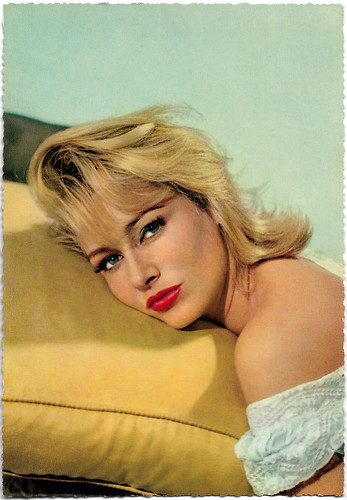
German postcard by Krüger, no. 902/91. Photo: Sam Lévin.
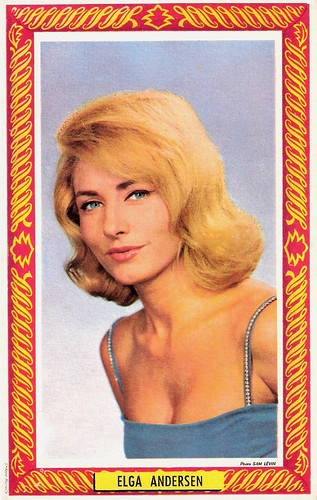
French postcard by St. Anne, Marseille. Photo: Sam Lévin.

French postcard by Editions P.I., Paris, no. 1053. Photo: Sam Lévin.
Bohemian Life
Elga Andersen was born Elga Hymen in Dortmund, Germany in 1935. She was the only child of a civil engineer. Two weeks before World War II ended, her parents had a quarrel so severe that her father left to join the Wehrmacht and was sent to the Russian front. He was never heard from again.
First Elga hoped to become a dancer but then studied French and English. To help support her mother, Elga quit school at 16 and worked for a while as an English and French interpreter.
In 1953, the 18-years-old went to Paris, where she led a bohemian life, met artists and posed for fashion shoots for various European magazines.
She made her film debut when she was discovered by director André Hunebelle. She appeared in Les Collégiennes/The Twilight Girls (André Hunebelle, 1957) as Elga Hymen.
The following year she appeared in a small role in Bonjour tristesse (Otto Preminger, 1958) with Jean Seberg . It was Preminger who suggested she renamed herself as Elga Andersen and as such she continued to work steadily mostly in European films and television up to 1974. Next followed a part in the classic thriller Ascenseur pour l'échafaud/Elevator to the Scaffold (Louis Malle, 1958), starring Jeanne Moreau and Maurice Ronet .
She also appeared in German productions like Ist Mama nicht fabelhaft?/Isn't Mama Fabulous? (Peter Beauvais, 1958) and So ein Millionär hat's schwer/Such a Millionaire has Tough Times (Géza von Cziffra, 1958) starring Peter Alexander .
Her first leading role was in the French-Brazilian adventure Os bandeirantes/The Pioneers (Marcel Camus, 1960).
Elga took singing lessons and performed the songs 'Treu sein' and 'Sündenlied' in The Guns of Navarrone (J. Lee Thompson, 1961). Gilbert Bécaud wrote especially for her 'Et maintenant', with words by Pierre Delanoë.
In 1962, she wed her first husband, French architect Christian Girard in Paris, but the marriage ended in a divorce.
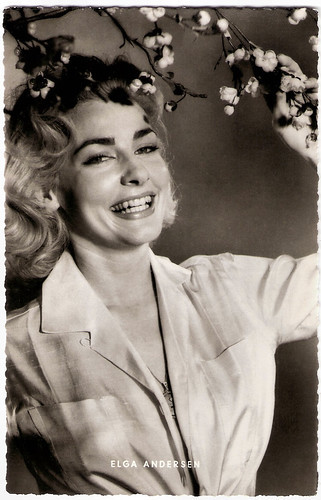
German postcard by Kunst und Bild, Berlin-Charlottenburg, no. A 1567. Photo: Hope / Gloria-Film / Niczky. Elga Andersen in Solang' die Sterne glüh'n/As long as the stars are glowing (Franz Antel, 1958).
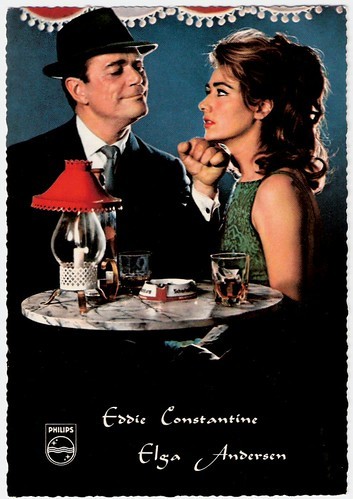
German postcard by Krüger, no. 902/35. Publicity card for Philips to promote the single Flüstertango/Heut' dreh'n wir mal ein Ding, Marcel (1963) with Eddie Constantine and Elga Andersen.
Listen to Flüstertango (1963). Source: 45Vault (YouTube).
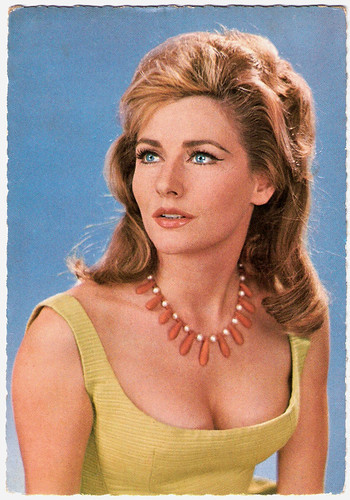
French postcard by E.D.U.G., no. 323. Photo: Sam Lévin.
Psychedelic Sixties Extravaganza
Elga Andersen appeared as a seductive beauty in many European films of the 1960s. Among them were the crime comedy Le Monocle Noir/The Black Monocle (Georges Lautner, 1961), and the sequel L'oeil du monocle/The Eye of the Monocle (Georges Lautner, 1962), both starring Paul Meurisse .
She appeared opposite Eddie Constantine as Lemmy Caution in the comic thrillers L'empire de la nuit/The Empire of Night (Pierre Grimblat, 1962) and A Toi de Faire Mignonne/Your Turn, Darling (Bernard Borderie, 1963).
Other films were the comedy DM-Killer (Rolf Thiele, 1965) with Curd Jürgens , the Spaghetti Western Starblack (Giovanni Grimaldi, 1966), and the psychedelic sixties extravaganza La battaglia dei mods/The Battle of the Mods (Franco Montemurro, 1966) with Joachim Fuchsberger and singer Ricky Shayne .
Andersen also appeared in such European films as the adventure Le Capitaine Singrid/Captain Singrid (Jean Leduc, 1967), Sex Power (Henry Charpin, 1970) with Jane Birkin , and the excellent comedy Detenuto in attesa di giudizio/Why? (Nanni Loy, 1971), starring Alberto Sordi.
Elga worked in a few Hollywood features too, credited as Helga Anderson, including A Global Affair (Jack Arnold, 1964) opposite Bob Hope.
She is best known for portraying Lisa Belgetti, Steve McQueen's love interest in the racing epic Le Mans (Lee H. Katzin, 1971). Andersen and McQueen reportedly had an affair during the filming. One of the Porsche 911 T sports coupes used in the production was given to Andersen as partial compensation for her work in the film.
When promoting Le Mans for Cinema Center Films, she met American producer and millionaire Peter R. Gimbel who was promoting his documentary on great white sharks, Blue Water, White Death (Peter Gimbel, James Lipscomb, 1971), for the same firm. Gimbel, heir to the Gimbel Department Stores, and Andersen married in 1978 and the couple stayed together till his death in 1987.
Her last film was Le Serpent/The Serpent (Henri Verneuil, 1973) starring Yul Brynner and Henry Fonda, and on TV she was last seen in the Sci-Fi series Aux frontières du possible/At the edge of the Possible (Victor Vicas, Claude Boissol, 1971-1974) with Pierre Vaneck.
Elga Andersen joined her husband on his various diving expeditions. In 1981 they tried to locate and salvage the bank safe of the sunken Italian ocean liner Andrea Doria. Andersen produced for TV the documentary Andrea Doria: The Final Chapter (Peter Gimbel, 1981) about this project that made many headlines.
Elga Andersen died of cancer in 1994, in New York City, USA. She was only fifty-nine. Andersen was cremated and divers placed her ashes, along with those of her husband inside the sunken hull of the Andrea Doria during the following year.
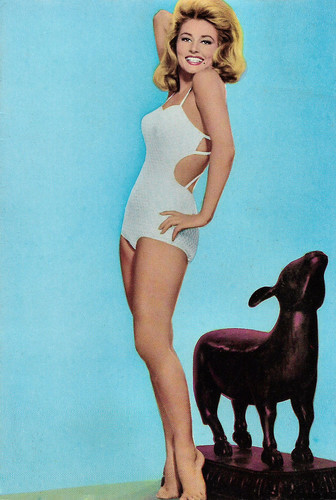
Spanish postcard by Raker, no. 1.158, 1965.
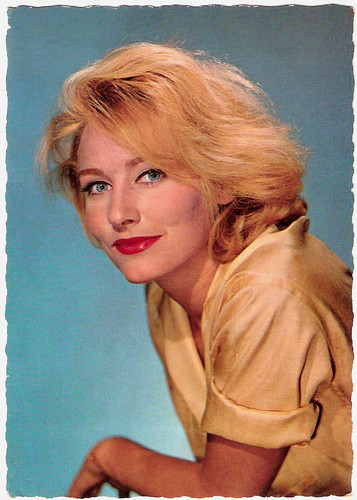
French postcard by E.D.U.G., no. 87. Photo: Sam Lévin.
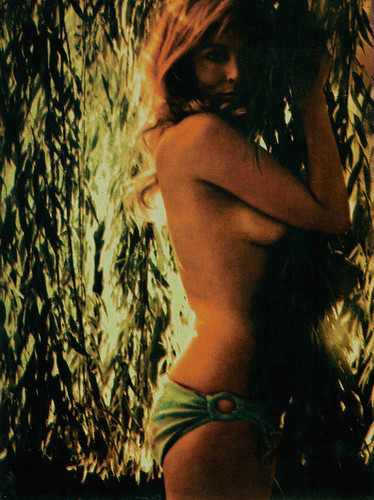
Yugoslavian postcard by Cik Razglednica.
Original trailer for Le Mans (Lee H. Katzin, 1971). Source: HD Retro Trailers (YouTube).
Sources: Sandra Brennan (AllMovie), Gioia Diliberto (People), Dan Scott (Find A Grave), Ray Young (Flickhead - now restricted), , and Wikipedia (German and English).

German postcard by Krüger, no. 902/91. Photo: Sam Lévin.

French postcard by St. Anne, Marseille. Photo: Sam Lévin.

French postcard by Editions P.I., Paris, no. 1053. Photo: Sam Lévin.
Bohemian Life
Elga Andersen was born Elga Hymen in Dortmund, Germany in 1935. She was the only child of a civil engineer. Two weeks before World War II ended, her parents had a quarrel so severe that her father left to join the Wehrmacht and was sent to the Russian front. He was never heard from again.
First Elga hoped to become a dancer but then studied French and English. To help support her mother, Elga quit school at 16 and worked for a while as an English and French interpreter.
In 1953, the 18-years-old went to Paris, where she led a bohemian life, met artists and posed for fashion shoots for various European magazines.
She made her film debut when she was discovered by director André Hunebelle. She appeared in Les Collégiennes/The Twilight Girls (André Hunebelle, 1957) as Elga Hymen.
The following year she appeared in a small role in Bonjour tristesse (Otto Preminger, 1958) with Jean Seberg . It was Preminger who suggested she renamed herself as Elga Andersen and as such she continued to work steadily mostly in European films and television up to 1974. Next followed a part in the classic thriller Ascenseur pour l'échafaud/Elevator to the Scaffold (Louis Malle, 1958), starring Jeanne Moreau and Maurice Ronet .
She also appeared in German productions like Ist Mama nicht fabelhaft?/Isn't Mama Fabulous? (Peter Beauvais, 1958) and So ein Millionär hat's schwer/Such a Millionaire has Tough Times (Géza von Cziffra, 1958) starring Peter Alexander .
Her first leading role was in the French-Brazilian adventure Os bandeirantes/The Pioneers (Marcel Camus, 1960).
Elga took singing lessons and performed the songs 'Treu sein' and 'Sündenlied' in The Guns of Navarrone (J. Lee Thompson, 1961). Gilbert Bécaud wrote especially for her 'Et maintenant', with words by Pierre Delanoë.
In 1962, she wed her first husband, French architect Christian Girard in Paris, but the marriage ended in a divorce.

German postcard by Kunst und Bild, Berlin-Charlottenburg, no. A 1567. Photo: Hope / Gloria-Film / Niczky. Elga Andersen in Solang' die Sterne glüh'n/As long as the stars are glowing (Franz Antel, 1958).

German postcard by Krüger, no. 902/35. Publicity card for Philips to promote the single Flüstertango/Heut' dreh'n wir mal ein Ding, Marcel (1963) with Eddie Constantine and Elga Andersen.
Listen to Flüstertango (1963). Source: 45Vault (YouTube).

French postcard by E.D.U.G., no. 323. Photo: Sam Lévin.
Psychedelic Sixties Extravaganza
Elga Andersen appeared as a seductive beauty in many European films of the 1960s. Among them were the crime comedy Le Monocle Noir/The Black Monocle (Georges Lautner, 1961), and the sequel L'oeil du monocle/The Eye of the Monocle (Georges Lautner, 1962), both starring Paul Meurisse .
She appeared opposite Eddie Constantine as Lemmy Caution in the comic thrillers L'empire de la nuit/The Empire of Night (Pierre Grimblat, 1962) and A Toi de Faire Mignonne/Your Turn, Darling (Bernard Borderie, 1963).
Other films were the comedy DM-Killer (Rolf Thiele, 1965) with Curd Jürgens , the Spaghetti Western Starblack (Giovanni Grimaldi, 1966), and the psychedelic sixties extravaganza La battaglia dei mods/The Battle of the Mods (Franco Montemurro, 1966) with Joachim Fuchsberger and singer Ricky Shayne .
Andersen also appeared in such European films as the adventure Le Capitaine Singrid/Captain Singrid (Jean Leduc, 1967), Sex Power (Henry Charpin, 1970) with Jane Birkin , and the excellent comedy Detenuto in attesa di giudizio/Why? (Nanni Loy, 1971), starring Alberto Sordi.
Elga worked in a few Hollywood features too, credited as Helga Anderson, including A Global Affair (Jack Arnold, 1964) opposite Bob Hope.
She is best known for portraying Lisa Belgetti, Steve McQueen's love interest in the racing epic Le Mans (Lee H. Katzin, 1971). Andersen and McQueen reportedly had an affair during the filming. One of the Porsche 911 T sports coupes used in the production was given to Andersen as partial compensation for her work in the film.
When promoting Le Mans for Cinema Center Films, she met American producer and millionaire Peter R. Gimbel who was promoting his documentary on great white sharks, Blue Water, White Death (Peter Gimbel, James Lipscomb, 1971), for the same firm. Gimbel, heir to the Gimbel Department Stores, and Andersen married in 1978 and the couple stayed together till his death in 1987.
Her last film was Le Serpent/The Serpent (Henri Verneuil, 1973) starring Yul Brynner and Henry Fonda, and on TV she was last seen in the Sci-Fi series Aux frontières du possible/At the edge of the Possible (Victor Vicas, Claude Boissol, 1971-1974) with Pierre Vaneck.
Elga Andersen joined her husband on his various diving expeditions. In 1981 they tried to locate and salvage the bank safe of the sunken Italian ocean liner Andrea Doria. Andersen produced for TV the documentary Andrea Doria: The Final Chapter (Peter Gimbel, 1981) about this project that made many headlines.
Elga Andersen died of cancer in 1994, in New York City, USA. She was only fifty-nine. Andersen was cremated and divers placed her ashes, along with those of her husband inside the sunken hull of the Andrea Doria during the following year.

Spanish postcard by Raker, no. 1.158, 1965.

French postcard by E.D.U.G., no. 87. Photo: Sam Lévin.

Yugoslavian postcard by Cik Razglednica.
Original trailer for Le Mans (Lee H. Katzin, 1971). Source: HD Retro Trailers (YouTube).
Sources: Sandra Brennan (AllMovie), Gioia Diliberto (People), Dan Scott (Find A Grave), Ray Young (Flickhead - now restricted), , and Wikipedia (German and English).
Published on December 07, 2019 22:00
December 6, 2019
The Girls of Progress
VEB Progress Filmvertrieb had the monopoly on film distribution in East-Germany and produced thousands of wonderful star postcards to help promote the films. These cards give a unique impression of the East-block stars in the 1960s and 1970s. Photographers like Linke, Schwarz and Balinski portrayed many young actors from Poland, Russia, Hungary, Czechoslovakia and East-Germany in a black and white, non-glamorous but very attractive style. For this post we selected 25 of these Progress postcards with beautiful pictures of young actresses. From another time, another world.
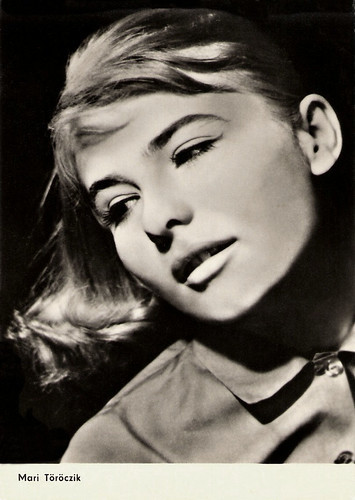
East-German postcard by VEB Progress Film-Vertrieb, Berlin, no. 2036, 1965. Retail price: 0,20 MDN.
Ever since her first film appearance Mari Töröcsik (1935) has been the leading Hungarian screen actress. The sensitive and intelligent actress played a great diversity of roles both on stage and for the camera. During her long career she appeared in more than 120 films and TV films.

East-German postcard by VEB Progress Film-Vertrieb, Berlin, no. 2569., 1966. Photo: Arno Fischer.
German actress Annekathrin Bürger (1937) was one of the prominent DEFA stars in the GDR during the 1960s and 1970s. She also appeared in television series such as Wolf Among Wolves (1965), set in 1920s Berlin.
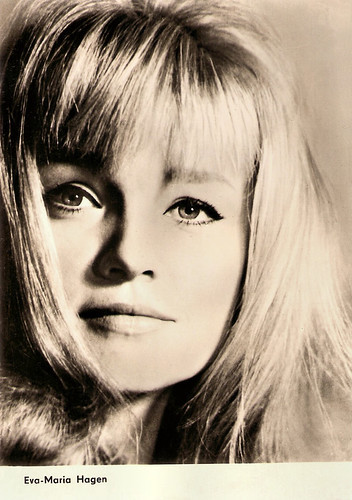
East-German postcard by VEB Progress Film-Vertrieb, Berlin, no. 2730, 1966. Retail price: 0,20 MDN.
German actress Eva-Maria Hagen (1934) is also a well-known singer, painter and author. From 1957 till 1965 she appeared in some 50 films and TV-productions and became known as "East-Germany’s Brigitte Bardot".
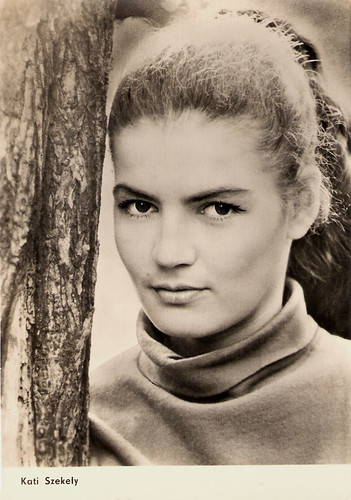
East-German postcard by VEB Progress Film-Vertrieb, Berlin, no. 2740, 1966. Retail price: 0,20 DM. Photo: Schwarz.
German actress Kati Székely (1941) is a former star of the DEFA studio.
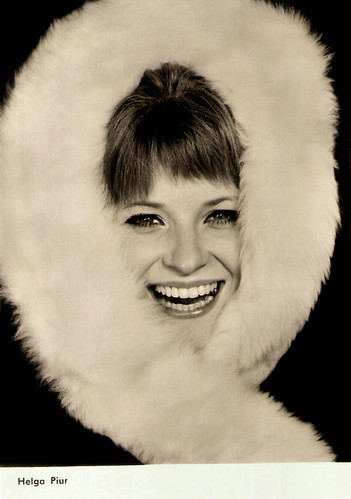
East-German postcard by VEB Progress Film-Vetrieb, Berlin, no. 27/49, 1967. Photo: DEWAG / Herbst.
Helga Piur (1939), is a German actress and voice actress, who was mainly known for her TV roles in the GDR. She also appeared in DEFA films of the 1960s.
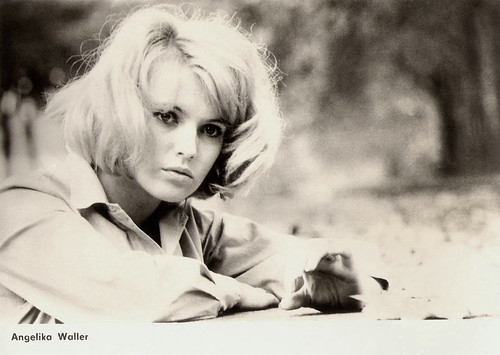
Big East-German card by VEB Progress Film-Vertrieb, Berlin, no. 2985, 1967. Photo: Balinski.
East German actress Angelika Waller (1944) appeared in more than hundred films and TV productions since 1962. Her first leading role was in Das Kaninchen bin ich/The Rabbit Is Me (1965), a film which was banned in East Germany and which had its world premiere only in 1989.
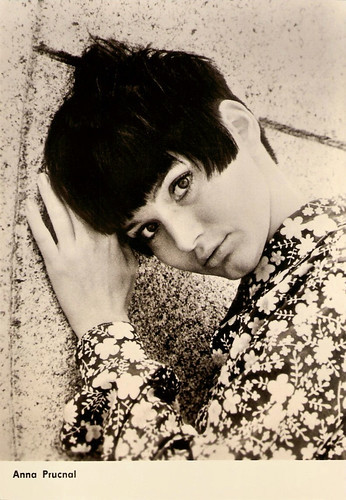
East-German postcard by VEB Progress Film-Vertrieb, Berlin, no. 3001, 1967. Retail price: 0,20 MDN. Photo: Balinski.
Beautiful Polish actress Anna Prucnal (1940) was a star of the East-European cinema of the 1960’s. From 1970 on she worked in France as an actress as well as a successful singer. Her role in the controversial and shocking film Sweet Movie (1974) caused her to be banned from her homeland for 15 years.
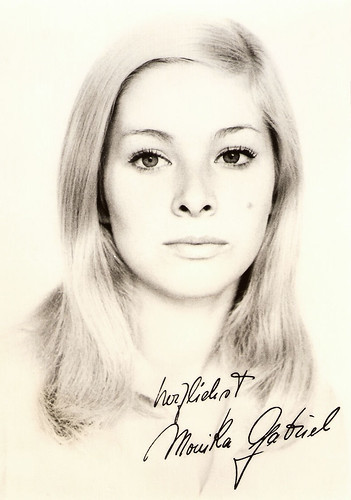
East-German postcard by VEB Progress Film-Vertrieb, Berlin, no. 3324, 1969. Photo: Schwarz.
German actress Monika Gabriel (1943-2007) was known for her many DEFA films and her appearances in TV series in East-Germany. From 1971, she worked in West-Germany, mainly for television.
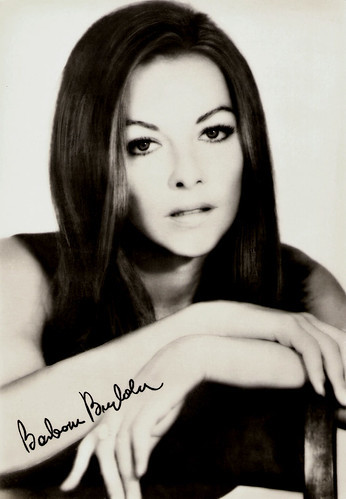
Big East-German card by VEB Progress Film-Vertrieb, Berlin, no. 112/69, 1969. Retail price: 0,40 MDN. Photo: Nasierowska.
During the 1970s, Polish actress Barbara Brylska (1941) was featured in numerous films throughout the countries of the Warsaw Pact. She is noted especially for her role as Nadya in the classic Soviet comedy Ironiya sudby/Irony of Fate (1975).
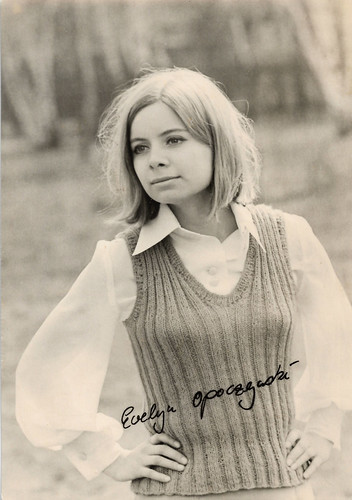
East-German postcard by VEB Progress Film-Vertrieb, no. 184/69, 1969. Photo: Uhlenhut.
Evelyn Opoczynski (1949) is a German actress and assistant director, known for for such DEFA films as Meine Freundin Sybille (1967), Du und ich und Klein-Paris (1971), and Sieben Sommersprossen (1978).
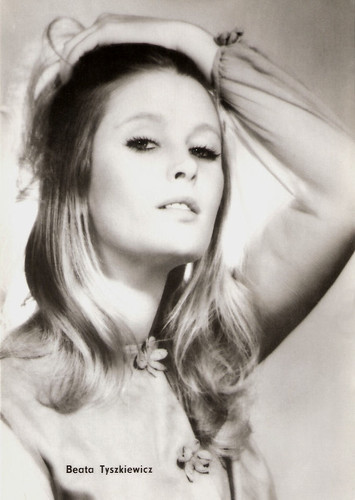
East-German postcard by VEB Progress Film-Vertrieb, Berlin, no. 190/69, 1969. Retail price: 0,20 MDN.
Beata Tyszkiewicz (1938) is one of Poland’s quintessential film beauties and she is referred to as the First lady of the Polish cinema. Exclusively working for the cinema, she appeared in more than 100 films.
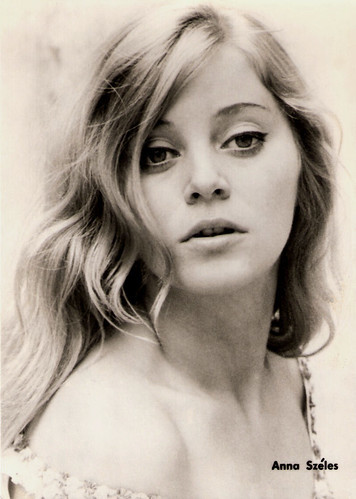
East-German postcard by VEB Progress Filmvertrieb, no. 212/69, 1969. Photo: Balinski.
Hungarian, Romanian-born Anna Széles (1942) was a ravishingly beautiful actress, who worked with directors like Miklós Jancsó and Péter Bacsó. She also appeared in Communist musicals of the 1960s and as a princess in East-European fairy tales of the 1970s.
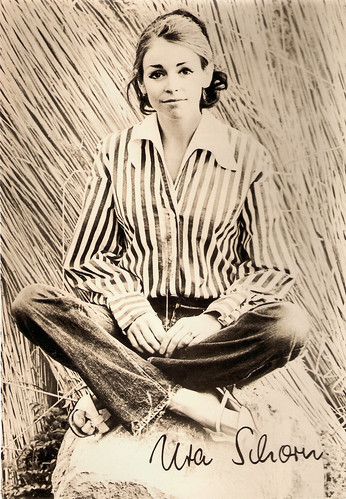
Big East-German card by VEB Progress Film-Vertrieb, Berlin, no. 247/69, 1969. Photo: Linke.
Caption: In the October days of the year 1969, we encountered the graceful Uta Schorn for the first time on the screen in the role of intern Renate in Verdacht auf einen Toten/Suspicion of a Dead (Rainer Bär, 1969). Moved from the classrooms of the Staatliche Schauspielschule Berlin by director Rainer Bär into the atmosphere of life on a large stud farm, the acting debutante secured with this role a permanent place with her future film and theatre audience.
In the youth clubs of the Deutsches Theater and the Volksbühne Berlin, Uta Schorn's decision was made to imitate her parents and also to climb the "Thespis cart". And so came after a well-passed high school graduation and acquisition of the skilled worker's letter as a gardener, the intake exam at the Staatliche Schauspielbühne Berlin. The young student later wants to try everything the stage offers, from the classical play to the musical. For now, however, it means for Uta Schorn to finish her studies with good results. So: toi, toi, toi.
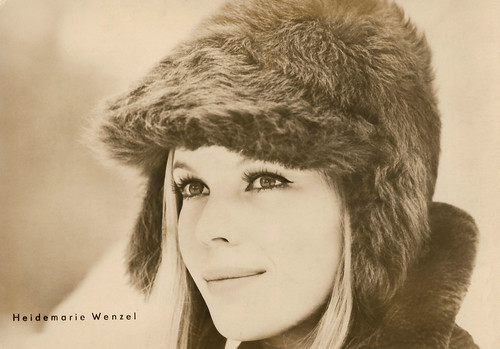
East-German postcard by VEB Progress Film-Vertrieb, Berlin, no. 167/70, 1970. Retail price: 0,20 MDN. Photo: Uhlenhut.
German actress Heidemarie Wenzel (1945) became known in DEFA films of the early 1970s, such as Zeit der Störche/Time of the storks (1971) and Nemuritorii (1974).
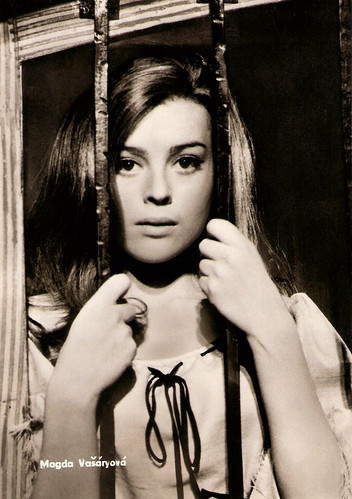
East-German postcard by VEB Progress Film-Vertrieb, Berlin, no. 51/71, 1971. Photo: Magda Vásáryová in Na komete/On the Comet (Karel Zeman, 1970).
Magda or Magdaléna Vášáryová (1948) is a Slovak Actress and diplomat. She is prominent for her liberal anti-nationalist stances and for such popular films as Marketa Lazarová (1967).
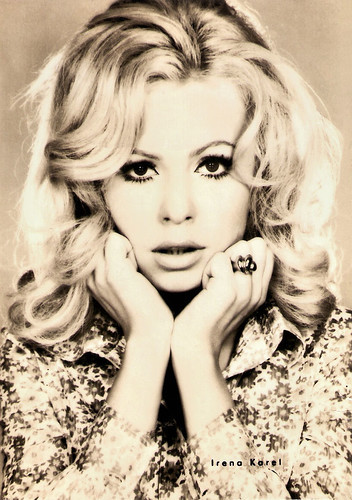
East-German postcard by VEB Progress Film-Vertrieb, Berlin, no. 71/71, 1971. Retail price: 0,20 MDN. Photo: Nasierowska.
Irena Karel (1943) is a Polish theatre and film actress and cabaret artist. She was called 'the Polish Brigitte Bardot'.
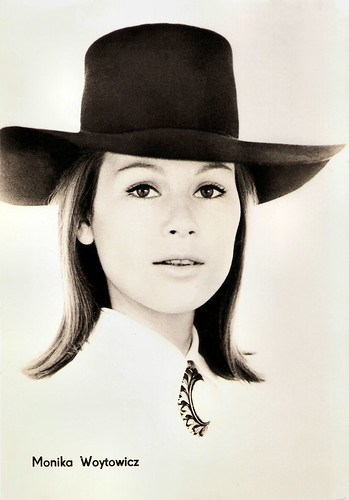
Big East-German card by VEB Progress Film-Vertrieb, Berlin, no. 82/71, 1971. Photo: Schwarz.
Caption: Her latest film role seems tailor-made for her: temperamental, a little bit cool and full of charm - as she is herself - she plays the dancer Peggy in Konrad Petzold's new Indian film Osceala. After a four-year break, Monika Woytowicz is back on the screen. Her last film was Das Mädchen auf dem brett/The Girl on the Board, still as a student at the Leipzig Theater, she played in Mir nach, Canaillen!/After me, scoundrels!, she became known through her role as Gundel in Die Abenteuer des Werner Holt/The Adventures of Werner Holt. The young actress has found her artistic home at the Städtische Theater Leipzig.
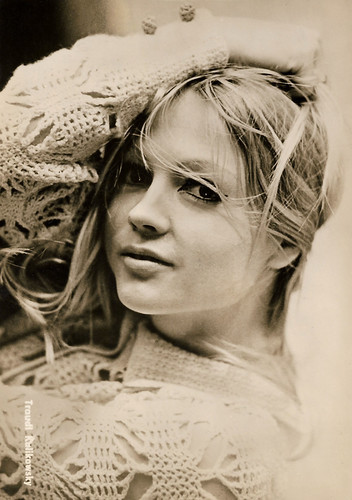
East-German postcard by VEB Progress Filmvertrieb, no. 105/71, 1971. Photo: Linke.
In the 1960s and early 1970s, German actress Traudl (or Traudel) Kulikowsky (1943) was one of the most popular young actors of the DDR (GDR), also because of her youthful, fresh appearance. After the Wende, it became known that she also had worked as a Stasi spy.
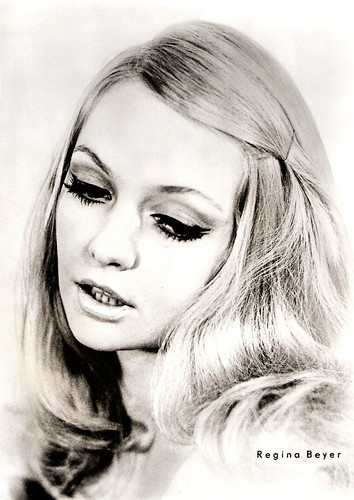
East-German postcard by VEB Progress Film-Vertrieb, Berlin, no. 114/73, 1973. Photo: Günter Linke.
German actress Regina Beyer (1947) starred in many DEFA films of 1960s and 1970s but she became most popular with her TV appearances for the East-German Television (DFF). She also worked for the theatre and the radio.
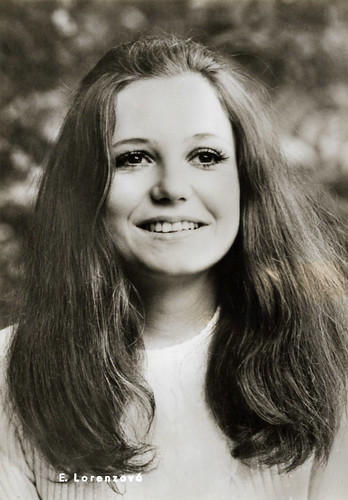
East-German postcard by VEB Progress Film-Vertrieb, Berlin, no. 151/72. Photo: Linke.
Eva Lorenzová (1948) is a Czech actress, who appeared in supporting parts in a dozen Czech films during the 1970s.
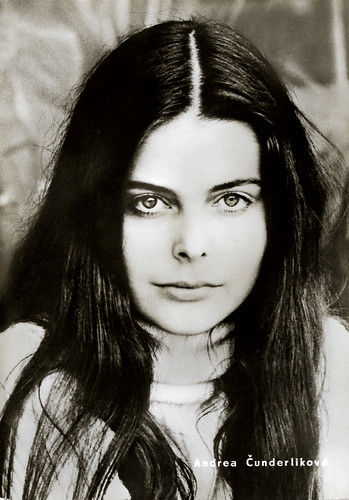
East-German postcard by VEB Progress Film-Vertrieb, Berlin, no. 172/74, 1974. Photo: Linke.
Czech actress Andrea Čunderlíková (1952) appeared in films, on stage and on television. She began in 1964 as a child star in Czech films and later became a star as nurse Ina in the popular Czech TV series Nemocnice na kraji města/Hospital on the Edge of the City (1978-1981).
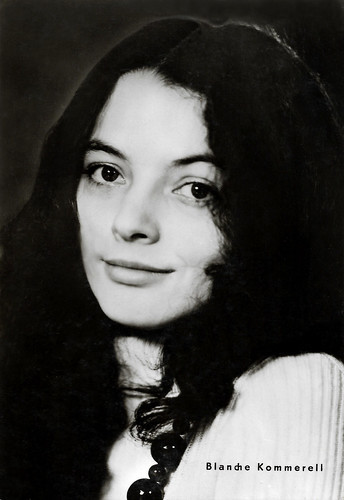
East-German postcard by VEB Progress Film-Vertrieb, Berlin, no. 92/76, 1976. Photo: Linke.
Blanche Kommerell (1950) is a German actress and writer. She has appeared in more than fifty films since 1962.
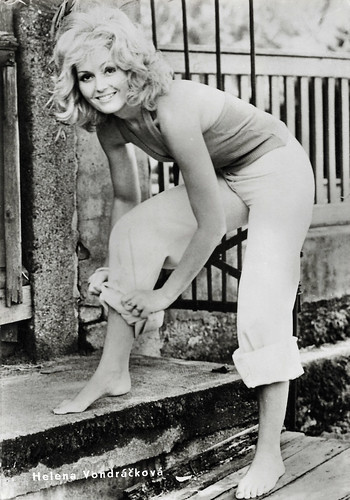
East-German postcard by VEB Progress Film-Vertrieb, Berlin, no. 100/76, 1976. Photo: Linke.
Helena Vondráčková (1947) is a Czech singer and actress whose career has spanned five decades. She is the best selling singer ever of her country. The Czech pop diva also appeared in films and stage musicals.
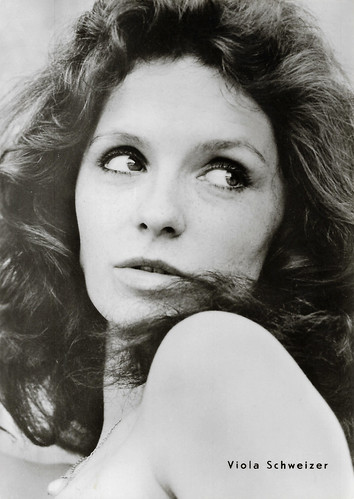
East-German postcard by VEB Progress Film-Vertrieb, Berlin, no. 159/78, 1978. Photo: Söhner. Publicity still for the TV film Über sieben Brücken musst du gehen/You have seven bridges to cross (Hans Werner, 1978).
German actress Viola Schweizer (1954) is known for such TV series as Polizeiruf 110/Police Call 110 (1974-1989), Spreewaldfamilie/Spreewald Family (1990) and Tatort/Crime Scene (1995). In former East Germany, she also appeared in several DEFA films. In 2001, she finished her acting career.

East-German postcard by VEB Progress Film-Vertrieb, Berlin, no. 75/79, 1979. Photo: Ute Mahler.
Karin Düwel (1954) is a German actress, who had her breakthrough in the DEFA film Sabine Wulff (1978), followed by such films as the popular family film Das Schulgespenst/The school ghost (1986). She also appeared in many German TV series and on stage.
For more postcards, check out our Flickr album Girls from Progress.

East-German postcard by VEB Progress Film-Vertrieb, Berlin, no. 2036, 1965. Retail price: 0,20 MDN.
Ever since her first film appearance Mari Töröcsik (1935) has been the leading Hungarian screen actress. The sensitive and intelligent actress played a great diversity of roles both on stage and for the camera. During her long career she appeared in more than 120 films and TV films.

East-German postcard by VEB Progress Film-Vertrieb, Berlin, no. 2569., 1966. Photo: Arno Fischer.
German actress Annekathrin Bürger (1937) was one of the prominent DEFA stars in the GDR during the 1960s and 1970s. She also appeared in television series such as Wolf Among Wolves (1965), set in 1920s Berlin.

East-German postcard by VEB Progress Film-Vertrieb, Berlin, no. 2730, 1966. Retail price: 0,20 MDN.
German actress Eva-Maria Hagen (1934) is also a well-known singer, painter and author. From 1957 till 1965 she appeared in some 50 films and TV-productions and became known as "East-Germany’s Brigitte Bardot".

East-German postcard by VEB Progress Film-Vertrieb, Berlin, no. 2740, 1966. Retail price: 0,20 DM. Photo: Schwarz.
German actress Kati Székely (1941) is a former star of the DEFA studio.

East-German postcard by VEB Progress Film-Vetrieb, Berlin, no. 27/49, 1967. Photo: DEWAG / Herbst.
Helga Piur (1939), is a German actress and voice actress, who was mainly known for her TV roles in the GDR. She also appeared in DEFA films of the 1960s.

Big East-German card by VEB Progress Film-Vertrieb, Berlin, no. 2985, 1967. Photo: Balinski.
East German actress Angelika Waller (1944) appeared in more than hundred films and TV productions since 1962. Her first leading role was in Das Kaninchen bin ich/The Rabbit Is Me (1965), a film which was banned in East Germany and which had its world premiere only in 1989.

East-German postcard by VEB Progress Film-Vertrieb, Berlin, no. 3001, 1967. Retail price: 0,20 MDN. Photo: Balinski.
Beautiful Polish actress Anna Prucnal (1940) was a star of the East-European cinema of the 1960’s. From 1970 on she worked in France as an actress as well as a successful singer. Her role in the controversial and shocking film Sweet Movie (1974) caused her to be banned from her homeland for 15 years.

East-German postcard by VEB Progress Film-Vertrieb, Berlin, no. 3324, 1969. Photo: Schwarz.
German actress Monika Gabriel (1943-2007) was known for her many DEFA films and her appearances in TV series in East-Germany. From 1971, she worked in West-Germany, mainly for television.

Big East-German card by VEB Progress Film-Vertrieb, Berlin, no. 112/69, 1969. Retail price: 0,40 MDN. Photo: Nasierowska.
During the 1970s, Polish actress Barbara Brylska (1941) was featured in numerous films throughout the countries of the Warsaw Pact. She is noted especially for her role as Nadya in the classic Soviet comedy Ironiya sudby/Irony of Fate (1975).

East-German postcard by VEB Progress Film-Vertrieb, no. 184/69, 1969. Photo: Uhlenhut.
Evelyn Opoczynski (1949) is a German actress and assistant director, known for for such DEFA films as Meine Freundin Sybille (1967), Du und ich und Klein-Paris (1971), and Sieben Sommersprossen (1978).

East-German postcard by VEB Progress Film-Vertrieb, Berlin, no. 190/69, 1969. Retail price: 0,20 MDN.
Beata Tyszkiewicz (1938) is one of Poland’s quintessential film beauties and she is referred to as the First lady of the Polish cinema. Exclusively working for the cinema, she appeared in more than 100 films.

East-German postcard by VEB Progress Filmvertrieb, no. 212/69, 1969. Photo: Balinski.
Hungarian, Romanian-born Anna Széles (1942) was a ravishingly beautiful actress, who worked with directors like Miklós Jancsó and Péter Bacsó. She also appeared in Communist musicals of the 1960s and as a princess in East-European fairy tales of the 1970s.

Big East-German card by VEB Progress Film-Vertrieb, Berlin, no. 247/69, 1969. Photo: Linke.
Caption: In the October days of the year 1969, we encountered the graceful Uta Schorn for the first time on the screen in the role of intern Renate in Verdacht auf einen Toten/Suspicion of a Dead (Rainer Bär, 1969). Moved from the classrooms of the Staatliche Schauspielschule Berlin by director Rainer Bär into the atmosphere of life on a large stud farm, the acting debutante secured with this role a permanent place with her future film and theatre audience.
In the youth clubs of the Deutsches Theater and the Volksbühne Berlin, Uta Schorn's decision was made to imitate her parents and also to climb the "Thespis cart". And so came after a well-passed high school graduation and acquisition of the skilled worker's letter as a gardener, the intake exam at the Staatliche Schauspielbühne Berlin. The young student later wants to try everything the stage offers, from the classical play to the musical. For now, however, it means for Uta Schorn to finish her studies with good results. So: toi, toi, toi.

East-German postcard by VEB Progress Film-Vertrieb, Berlin, no. 167/70, 1970. Retail price: 0,20 MDN. Photo: Uhlenhut.
German actress Heidemarie Wenzel (1945) became known in DEFA films of the early 1970s, such as Zeit der Störche/Time of the storks (1971) and Nemuritorii (1974).

East-German postcard by VEB Progress Film-Vertrieb, Berlin, no. 51/71, 1971. Photo: Magda Vásáryová in Na komete/On the Comet (Karel Zeman, 1970).
Magda or Magdaléna Vášáryová (1948) is a Slovak Actress and diplomat. She is prominent for her liberal anti-nationalist stances and for such popular films as Marketa Lazarová (1967).

East-German postcard by VEB Progress Film-Vertrieb, Berlin, no. 71/71, 1971. Retail price: 0,20 MDN. Photo: Nasierowska.
Irena Karel (1943) is a Polish theatre and film actress and cabaret artist. She was called 'the Polish Brigitte Bardot'.

Big East-German card by VEB Progress Film-Vertrieb, Berlin, no. 82/71, 1971. Photo: Schwarz.
Caption: Her latest film role seems tailor-made for her: temperamental, a little bit cool and full of charm - as she is herself - she plays the dancer Peggy in Konrad Petzold's new Indian film Osceala. After a four-year break, Monika Woytowicz is back on the screen. Her last film was Das Mädchen auf dem brett/The Girl on the Board, still as a student at the Leipzig Theater, she played in Mir nach, Canaillen!/After me, scoundrels!, she became known through her role as Gundel in Die Abenteuer des Werner Holt/The Adventures of Werner Holt. The young actress has found her artistic home at the Städtische Theater Leipzig.

East-German postcard by VEB Progress Filmvertrieb, no. 105/71, 1971. Photo: Linke.
In the 1960s and early 1970s, German actress Traudl (or Traudel) Kulikowsky (1943) was one of the most popular young actors of the DDR (GDR), also because of her youthful, fresh appearance. After the Wende, it became known that she also had worked as a Stasi spy.

East-German postcard by VEB Progress Film-Vertrieb, Berlin, no. 114/73, 1973. Photo: Günter Linke.
German actress Regina Beyer (1947) starred in many DEFA films of 1960s and 1970s but she became most popular with her TV appearances for the East-German Television (DFF). She also worked for the theatre and the radio.

East-German postcard by VEB Progress Film-Vertrieb, Berlin, no. 151/72. Photo: Linke.
Eva Lorenzová (1948) is a Czech actress, who appeared in supporting parts in a dozen Czech films during the 1970s.

East-German postcard by VEB Progress Film-Vertrieb, Berlin, no. 172/74, 1974. Photo: Linke.
Czech actress Andrea Čunderlíková (1952) appeared in films, on stage and on television. She began in 1964 as a child star in Czech films and later became a star as nurse Ina in the popular Czech TV series Nemocnice na kraji města/Hospital on the Edge of the City (1978-1981).

East-German postcard by VEB Progress Film-Vertrieb, Berlin, no. 92/76, 1976. Photo: Linke.
Blanche Kommerell (1950) is a German actress and writer. She has appeared in more than fifty films since 1962.

East-German postcard by VEB Progress Film-Vertrieb, Berlin, no. 100/76, 1976. Photo: Linke.
Helena Vondráčková (1947) is a Czech singer and actress whose career has spanned five decades. She is the best selling singer ever of her country. The Czech pop diva also appeared in films and stage musicals.

East-German postcard by VEB Progress Film-Vertrieb, Berlin, no. 159/78, 1978. Photo: Söhner. Publicity still for the TV film Über sieben Brücken musst du gehen/You have seven bridges to cross (Hans Werner, 1978).
German actress Viola Schweizer (1954) is known for such TV series as Polizeiruf 110/Police Call 110 (1974-1989), Spreewaldfamilie/Spreewald Family (1990) and Tatort/Crime Scene (1995). In former East Germany, she also appeared in several DEFA films. In 2001, she finished her acting career.

East-German postcard by VEB Progress Film-Vertrieb, Berlin, no. 75/79, 1979. Photo: Ute Mahler.
Karin Düwel (1954) is a German actress, who had her breakthrough in the DEFA film Sabine Wulff (1978), followed by such films as the popular family film Das Schulgespenst/The school ghost (1986). She also appeared in many German TV series and on stage.
For more postcards, check out our Flickr album Girls from Progress.
Published on December 06, 2019 21:30
December 5, 2019
Dolores Costello
American film actress Dolores Costello (1903-1979) was 'The Goddess of the Silent Screen'. She was Hollywood royalty: the daughter of popular matinee idol Maurice Costello, wife of John Barrymore and grandmother of Drew Barrymore.
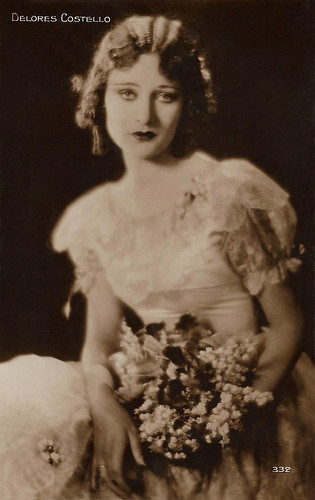
French postcard by Editions Cinémagazine, no. 332. NB Costello's first name is misspelled on the postcard.
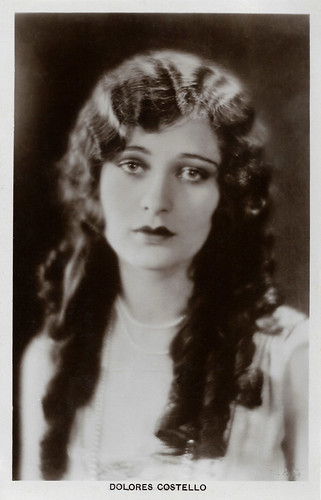
British postcard in the Picturegoer Series, London, no. 262.
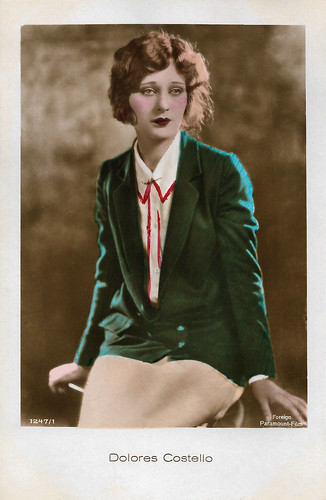
German postcard by Ross Verlag Foreign, no. 1247/1, 1927-1928. Photo: Paramount-Film.
Fainting during a lengthy kissing scene
Dolores Costello was born in Pittsburgh, Pennsylvania in 1903. She was the daughter of actors Maurice Costello and Mae Costello (née Altschuk). Her youth was spent mostly on Long Island, where she was educated by a tutor.
With her younger sister, Helene, she made her first film appearances in the years 1909–1915 as child actress for the Vitagraph Film Company. They played supporting roles in several films starring their father, who was a popular matinee idol at the time. Dolores Costello's earliest listed credit on IMDb is in the role of a fairy in a 1909 adaptation of Shakespeare's A Midsummer Night's Dream (Charles Kent, J. Stuart Blackton, 1909).
Dolores started her career as a model and posed for the noted James Montgomery Flagg, who described her beauty as the most perfect for his illustrations. The two Costello sisters appeared on Broadway together as chorines in 'George White Scandals of 1924'. The production ran on Broadway for more than a year and then went on tour. In Chicago, they were signed by a talent scout for Warner Bros.
Following small parts in feature films, Dolores was selected by John Barrymore to star opposite him in The Sea Beast (Millard Webb, 1926), a loose adaptation of Herman Melville's 'Moby-Dick'. During their lengthy kissing scene Dolores fainted in John's arms. The film was a major commercial success and one of the biggest pictures of 1926 becoming Warner Brothers' highest grossing film.
Within a few years of achieving stardom, the delicately beautiful blonde-haired actress had become a successful and highly regarded film personality in her own right. As a young adult her career developed to the degree that in 1926, she was named a WAMPAS Baby Star, and had acquired the nickname 'The Goddess of the Silver Screen'.
Meanwhile, she and Barrymore became romantically involved. They starred together again in When a Man Loves (Alan Crosland, 1927). Then, Warner began starring her in her own vehicles. She married Barrymore in 1928 despite the misgivings of her mother, who would die the following year at the age of 45.
The young couple spent their honeymoon on his yacht, visiting Panama, the Galapagos Islands and Ecuador. They hunted alligators and mammoth lizards and explored wild regions of Central America before returning to Hollywood and moving into a hilltop mansion in Beverly Hills.
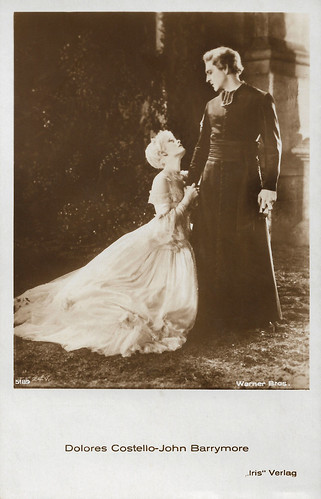
Austrian postcard by Iris-Verlag, no. 5189. Photo: Warner Bros. Dolores Costello and John Barrymore in When a Man Loves (Alan Crosland, 1927).
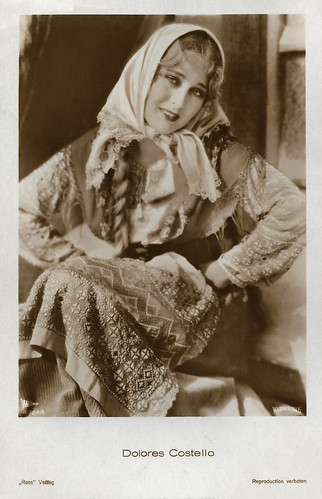
German postcard by Ross Verlag, no. 4424/1, 1929-1930. Photo: Warner Bros / Nationalfilm. Dolores Costello in Hearts in Exile (Michael Curtiz, 1929).
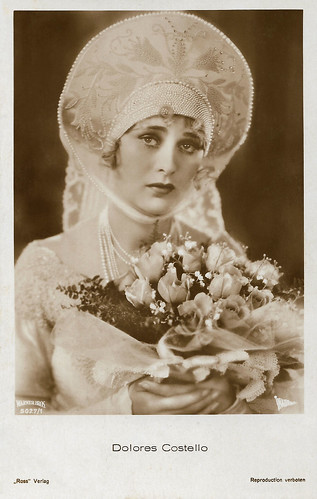
German postcard by Ross Verlag, no. 5027/1, 1929-1930. Photo: Warner Bros / Nationalfilm. Dolores Costello in Hearts in Exile (Michael Curtiz, 1929).
All-star extravaganza
Dolores Costello was alternated by Warner Bros between films with contemporary settings and elaborate costume dramas. In 1927, she was re-teamed with John Barrymore in When a Man Loves (Alan Crosland, 1927), an adaptation of 'Manon Lescaut'. The following year, she co-starred with George O'Brien in Noah's Ark (1928), a part-talkie epic directed by Michael Curtiz.
She then starred in Tenderloin (Michael Curtiz, 1928), which was the second Vitaphone feature to have talking sequences. It is considered a lost film, where today only the Vitaphone soundtrack survives.
Costello spoke with a lisp and found it difficult to make the transition to talking pictures, but after two years of voice coaching she was comfortable speaking before a microphone. One of her early sound film appearances was with her sister Helene in Warner Bros.'s all-star extravaganza The Show of Shows (John G. Adolfi, 1929).
Her acting career became less a priority for her following the birth of her first child, Dolores Ethel Mae 'DeeDee' Barrymore, in 1930, and she retired from the screen in 1931 to devote time to her family. Her second child, John Drew Barrymore, was born in 1932, but the marriage with John Barrymore proved difficult due to her husband's increasing alcoholism.
Her sister Helene and her new husband, actor Lowell Sherman, successfully convinced Dolores to divorce Barrymore in 1935, mainly because of his excessive drinking. She resumed her career a year later and achieved some successes, most notably in Little Lord Fauntleroy (John Cromwell, 1936) featuring Freddie Bartholomew, and The Magnificent Ambersons (Orson Welles, 1942), an adaptation of Booth Tarkington's novel about a crumbling 19th‐century aristocracy.
Making a rare radio appearance, Costello appeared as the Danish Countess Elsa on the radio program Suspense (1943). The title of the episode is The King's Birthday written by Corporal Leonard Pellitier of the US Army.
Her film career was largely ruined by the destructive effects of early film makeup, which ravaged her complexion too severely to camouflage. She retired permanently from acting following her appearance in This is the Army (Michael Curtiz, 1943). In 1939, she had married Dr. John Vruwink, an obstetrician who was her physician during her pregnancies, but they divorced in 1950.
Costello spent the remaining years of her life in semi-seclusion, managing an avocado farm. In the 1970s her house was inundated in a flash flood which destroyed a lot of her property and memorabilia from her film career and life with John Barrymore. Shortly before her death, she was interviewed for the documentary series Hollywood (1980) discussing her film career. Her scenes were broadcast posthumously.
Dolores Costello died from emphysema in Fallbrook, California, in 1979, and is interred in Calvary Cemetery, East Los Angeles. She was stepmother of John Barrymore's daughter Diana, by his second wife Blanche Oelrichs, the mother of John Drew Barrymore and Dolores (Dee Dee) Barrymore, and the grandmother of John Barrymore III, Blyth Dolores Barrymore, Brahma Blyth (Jessica) Barrymore, and Drew Barrymore.
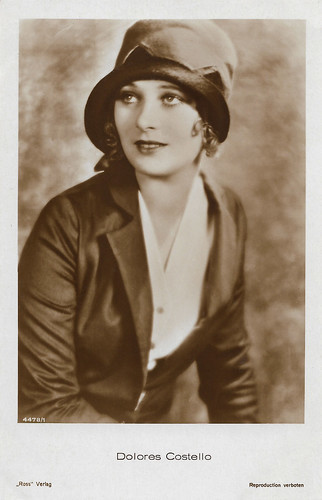
German postcard by Ross Verlag, no. 4478/1, 1929-1930. Collection: Geoffrey Donaldson Institute.
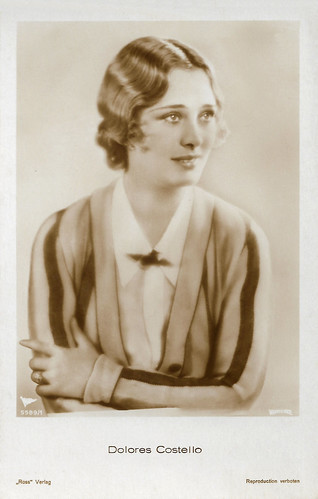
German postcard by Ross Verlag, no. 5589/1, 1929-1930. Photo: Warner Bros / Nationalfilm.
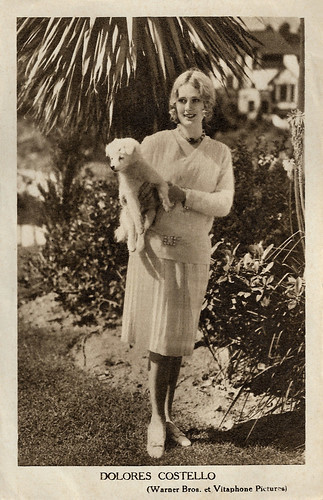
Belgian postcard by N.V. Universum, Antwerp. Photo: Warner Bros / Vitaphone Pictures.
Sources: Peters B. Flint (The New York Times), (IMDb), Wikipedia and .

French postcard by Editions Cinémagazine, no. 332. NB Costello's first name is misspelled on the postcard.

British postcard in the Picturegoer Series, London, no. 262.

German postcard by Ross Verlag Foreign, no. 1247/1, 1927-1928. Photo: Paramount-Film.
Fainting during a lengthy kissing scene
Dolores Costello was born in Pittsburgh, Pennsylvania in 1903. She was the daughter of actors Maurice Costello and Mae Costello (née Altschuk). Her youth was spent mostly on Long Island, where she was educated by a tutor.
With her younger sister, Helene, she made her first film appearances in the years 1909–1915 as child actress for the Vitagraph Film Company. They played supporting roles in several films starring their father, who was a popular matinee idol at the time. Dolores Costello's earliest listed credit on IMDb is in the role of a fairy in a 1909 adaptation of Shakespeare's A Midsummer Night's Dream (Charles Kent, J. Stuart Blackton, 1909).
Dolores started her career as a model and posed for the noted James Montgomery Flagg, who described her beauty as the most perfect for his illustrations. The two Costello sisters appeared on Broadway together as chorines in 'George White Scandals of 1924'. The production ran on Broadway for more than a year and then went on tour. In Chicago, they were signed by a talent scout for Warner Bros.
Following small parts in feature films, Dolores was selected by John Barrymore to star opposite him in The Sea Beast (Millard Webb, 1926), a loose adaptation of Herman Melville's 'Moby-Dick'. During their lengthy kissing scene Dolores fainted in John's arms. The film was a major commercial success and one of the biggest pictures of 1926 becoming Warner Brothers' highest grossing film.
Within a few years of achieving stardom, the delicately beautiful blonde-haired actress had become a successful and highly regarded film personality in her own right. As a young adult her career developed to the degree that in 1926, she was named a WAMPAS Baby Star, and had acquired the nickname 'The Goddess of the Silver Screen'.
Meanwhile, she and Barrymore became romantically involved. They starred together again in When a Man Loves (Alan Crosland, 1927). Then, Warner began starring her in her own vehicles. She married Barrymore in 1928 despite the misgivings of her mother, who would die the following year at the age of 45.
The young couple spent their honeymoon on his yacht, visiting Panama, the Galapagos Islands and Ecuador. They hunted alligators and mammoth lizards and explored wild regions of Central America before returning to Hollywood and moving into a hilltop mansion in Beverly Hills.

Austrian postcard by Iris-Verlag, no. 5189. Photo: Warner Bros. Dolores Costello and John Barrymore in When a Man Loves (Alan Crosland, 1927).

German postcard by Ross Verlag, no. 4424/1, 1929-1930. Photo: Warner Bros / Nationalfilm. Dolores Costello in Hearts in Exile (Michael Curtiz, 1929).

German postcard by Ross Verlag, no. 5027/1, 1929-1930. Photo: Warner Bros / Nationalfilm. Dolores Costello in Hearts in Exile (Michael Curtiz, 1929).
All-star extravaganza
Dolores Costello was alternated by Warner Bros between films with contemporary settings and elaborate costume dramas. In 1927, she was re-teamed with John Barrymore in When a Man Loves (Alan Crosland, 1927), an adaptation of 'Manon Lescaut'. The following year, she co-starred with George O'Brien in Noah's Ark (1928), a part-talkie epic directed by Michael Curtiz.
She then starred in Tenderloin (Michael Curtiz, 1928), which was the second Vitaphone feature to have talking sequences. It is considered a lost film, where today only the Vitaphone soundtrack survives.
Costello spoke with a lisp and found it difficult to make the transition to talking pictures, but after two years of voice coaching she was comfortable speaking before a microphone. One of her early sound film appearances was with her sister Helene in Warner Bros.'s all-star extravaganza The Show of Shows (John G. Adolfi, 1929).
Her acting career became less a priority for her following the birth of her first child, Dolores Ethel Mae 'DeeDee' Barrymore, in 1930, and she retired from the screen in 1931 to devote time to her family. Her second child, John Drew Barrymore, was born in 1932, but the marriage with John Barrymore proved difficult due to her husband's increasing alcoholism.
Her sister Helene and her new husband, actor Lowell Sherman, successfully convinced Dolores to divorce Barrymore in 1935, mainly because of his excessive drinking. She resumed her career a year later and achieved some successes, most notably in Little Lord Fauntleroy (John Cromwell, 1936) featuring Freddie Bartholomew, and The Magnificent Ambersons (Orson Welles, 1942), an adaptation of Booth Tarkington's novel about a crumbling 19th‐century aristocracy.
Making a rare radio appearance, Costello appeared as the Danish Countess Elsa on the radio program Suspense (1943). The title of the episode is The King's Birthday written by Corporal Leonard Pellitier of the US Army.
Her film career was largely ruined by the destructive effects of early film makeup, which ravaged her complexion too severely to camouflage. She retired permanently from acting following her appearance in This is the Army (Michael Curtiz, 1943). In 1939, she had married Dr. John Vruwink, an obstetrician who was her physician during her pregnancies, but they divorced in 1950.
Costello spent the remaining years of her life in semi-seclusion, managing an avocado farm. In the 1970s her house was inundated in a flash flood which destroyed a lot of her property and memorabilia from her film career and life with John Barrymore. Shortly before her death, she was interviewed for the documentary series Hollywood (1980) discussing her film career. Her scenes were broadcast posthumously.
Dolores Costello died from emphysema in Fallbrook, California, in 1979, and is interred in Calvary Cemetery, East Los Angeles. She was stepmother of John Barrymore's daughter Diana, by his second wife Blanche Oelrichs, the mother of John Drew Barrymore and Dolores (Dee Dee) Barrymore, and the grandmother of John Barrymore III, Blyth Dolores Barrymore, Brahma Blyth (Jessica) Barrymore, and Drew Barrymore.

German postcard by Ross Verlag, no. 4478/1, 1929-1930. Collection: Geoffrey Donaldson Institute.

German postcard by Ross Verlag, no. 5589/1, 1929-1930. Photo: Warner Bros / Nationalfilm.

Belgian postcard by N.V. Universum, Antwerp. Photo: Warner Bros / Vitaphone Pictures.
Sources: Peters B. Flint (The New York Times), (IMDb), Wikipedia and .
Published on December 05, 2019 22:00
December 4, 2019
Bernd Aldor
Bernd Aldor (1881-1950) was a star of the German silent cinema in the 1910s and 1920s, often in films by Richard Oswald or Lupu Pick. Sound film and the Nazi regime broke the career of this Jewish actor.
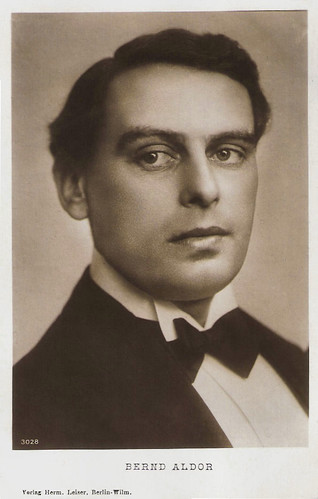
German postcard by Verlag Hermann Leiser, Berlin, no. 3028.
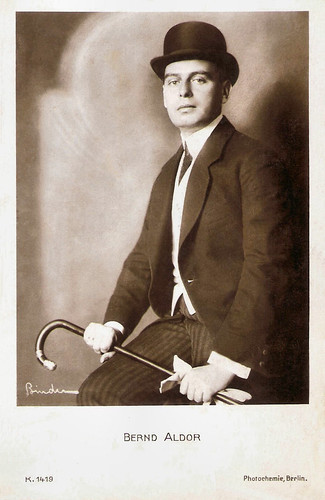
German postcard by Photochemie, no. K.1419. Photo: Alex Binder, Berlin.
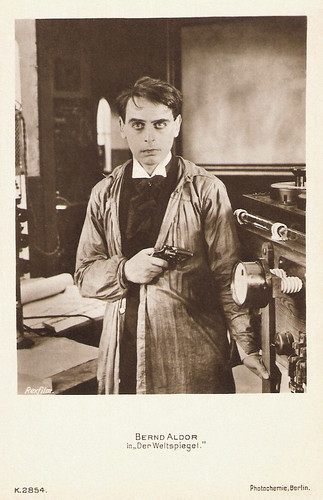
German postcard by Photochemie, Berlin, no. K.2854. Photo: Rexfilm. Bernd Aldor in Der Weltspiegel/The World Mirror (Lupu Pick, 1918).
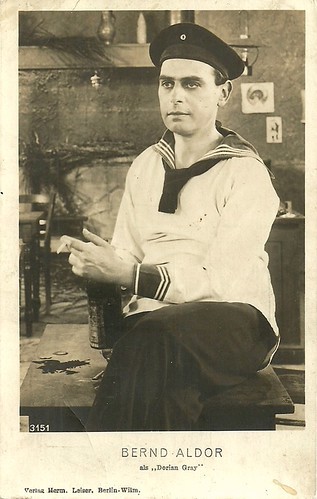
German postcard by Verlag Hermann Leiser, Berlin, no. 3151. Photo: Richard-Oswald-Produktion. Bernd Aldor as Dorian Gray in Das Bildnis des Dorian Gray/The Picture of Dorian Gray (Richard Oswald, 1917), an adaptation of Oscar Wilde's novel The Picture of Dorian Gray.
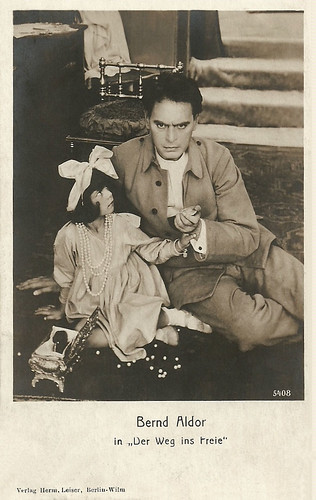
German postcard by Verlag Herman Leiser, Berlin, no. 5408. Photo: Bernd Aldor in Der Weg ins Freie/The way to the outdoors (Richard Oswald, 1918).
Aufklärungsfilme
Bernd Aldor was born in Constantinople, the former Ottoman Empire (now Istanbul, Turkey) in 1881 ( IMDb and Filmportal.de write wrongly 1887).
Shortly before the turn of the century he took acting lessons in Vienna at the master class of Karl Arnau. He began his theatrical career as an extra at the Hofburgtheater, the later Burgtheater.
In 1900 he received his first permanent engagement in Znaim (Znojmo). From 1903 on his other theatre stations included Czernowitz, Trier, Bremen, Königsberg, Leipzig, Dresden and Hamburg.
In 1906 he came to Berlin to work at the Schiller Theater. During a performance of Leo Tolstoy's The Living Corpse at the Schauspielhaus Leipzig he was discovered for the film by Charles Decroix.
His film debut was probably the German short film Die Czernowska/That Czernowska Woman (Charles Decroix, 1913), of which scenes were edited in Lyrisch Nitraat/Lyrical Nitrate (Peter Delpeut, 1991).
Other films he made with Decroix were Der Fleck/The Stain (Charles Decroix, 1913) starring Wolfgang Neff, and Das Ave Maria/The Ave Maria (Charles Decroix, 1913) opposite Fern Andra, the great American diva of the German silent cinema.
Aldor appeared also opposite another silent film diva, Henny Porten , in Die große Sünderin/The Great Sinner (Curt A. Stark, 1914), and with the young deceased Dorrit Weixler in Aschenbrödelchen/Little Cinderella (1915).
During WWI, he worked with director Richard Oswald for the first time, at Zirkusblut/Circus Blood (Richard Oswald, 1916) and at Seine letzte Maske/His last mask (Richard Oswald, 1916). In both films he played the lead role, like in most of his films during this period.
Aldor became well-known with his performances in the first two parts of a trilogy of Aufklärungsfilme (typical German educational films), Es werde Licht/There Will Be Light (Richard Oswald, 1917-1918). He played Dr. Mauthner, head of an institution for children suffering from syphilis.
He also appeared in Oswald's literary film adaptations Das Bildnis des Dorian Gray/The Picture of Dorian Gray (Richard Oswald, 1917) based on the classic novel by Oscar Wilde, and Tolstoy's Der lebende Leichnam/The Living Corpse (Richard Oswald, 1918), which he had earlier performed on stage.
From 1917 to 1919 he was also the star of several film by actor-writer-director Lupu Pick, such as Die Liebe des Van Royk/The Love of Van Royk (Lupu Pick, 1918), Der Weltspiegel/The Mirror World (Lupu Pick, 1918) and Mein Wille ist Gesetz/My will is law (Lupu Pick, 1919) with Olga Engl.
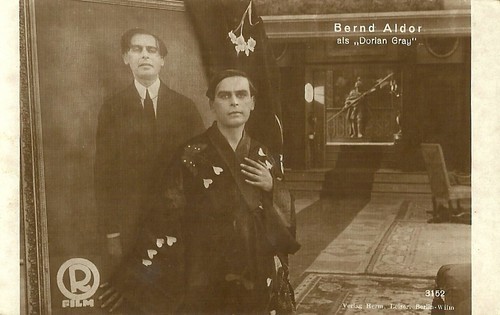
German postcard by Hermann Leiser Verlag, Berlin, no. 3152. Photo: Richard-Oswald-Produktion. Bernd Aldor in Das Bildnis des Dorian Gray (Richard Oswald, 1917), an adaptation of Oscar Wilde's The Picture of Dorian Gray.
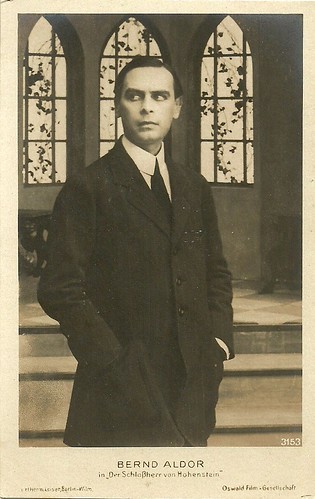
German postcard by Verlag Hermann Leiser, Berlin, no. 3153. Photo: Richard Oswald-Film. Bernd Aldor in Der Schloßherr von Hohenstein/The manor of Hohenstein (Richard Oswald, 1917).
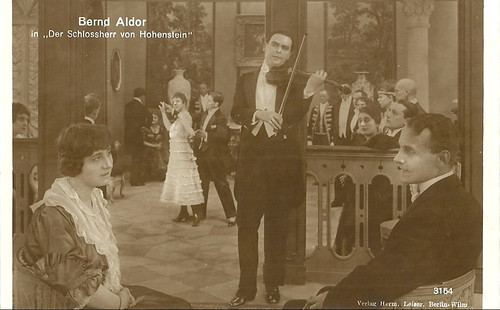
German postcard by Verlag Hermann Leiser, Berlin, no. 3154. Photo: Richard Oswald-Film. Bernd Aldor playing the violin in the German silent film Der Schloßherr von Hohenstein/The manor of Hohenstein (Richard Oswald, 1917).
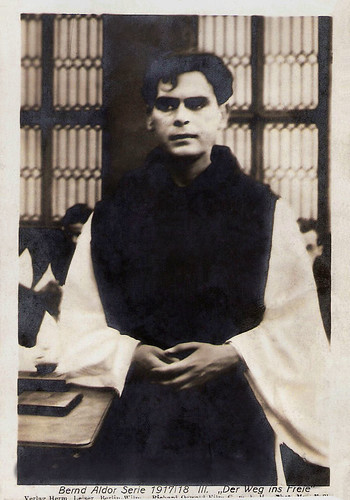
German postcard in the Bernd Aldor Series 1917/1918 III. by Verlag Herman Leiser, Berlin-Wilm. Phot: Richard Oswald Film. Bernd Aldor in Der Weg ins Freie (Richard Oswald, 1918).
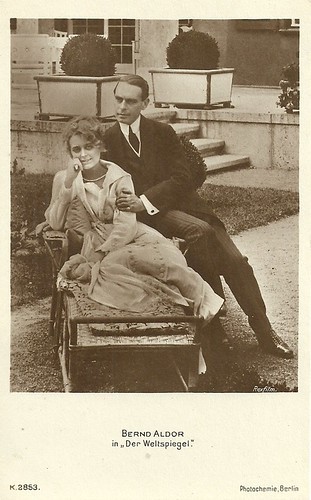
German postcard by Photochemie, Berlin, no. K.2853. Bernd Aldor in Der Weltspiegel/The World Mirror (Lupu Pick, 1918). The woman could be Gertrud Welcker.

German postcard by Photochemie, Berlin, K.2855. Photo: Rexfilm. Bernd Aldor in Die Liebe des van Royk/The Love of van Royk (Lupu Pick, 1917). Though the woman right of Aldor looks like Ria Jende, she is not named among the actresses in Filmportal.de. the postcard names the character von Royk instead of van Royk.

German postcard Photochemie, Berlin, no. K.2856. Photo: Rexfilm. Bernd Aldor in Die tolle Heirat von Laló/The great marriage of Laló (Lupu Pick, 1918).
Oblivion
Until the mid-1920s, Bernd Aldor was seen in leading roles. He starred as Talma opposite Fern Andra again in Madame Récamier (Joseph Delmont, 1920). In the drama Die Furcht vor dem Weibe/The fear of the woman (Hanna Henning, 1921) he starred opposite Otto Gebühr .
He appeared at the side of the great comedian Hermann Valentin in Graf Cohn/Count Cohn (Carl Boese, 1923), and with Claire Rommer in Aschermittwoch/Ash Wednesday (1925), directed by his old co-star Wolfgang Neff, who had turned into a director.
He reunited with Oswald for Halbseide/Half silk (Richard Oswald, 1925) as the husband of Mary Parker .
From 1927 on his film parts became smaller. He played supporting parts in Die glühende Gasse/The glowing alley (Paul Sugar, 1927) starring Hans Albers , the comedy Schwere Jungs - leichte Mädchen/Guys and Dolls (Carl Boese, 1927) starring Gustav Fröhlich and Lissi Arna , and Indizienbeweis/Circumstantial evidence (Georg Jacoby, 1929) starring Fritz Alberti.
Then he slowly fell into oblivion, but he did some small film appearances in the sound era. Richard Oswald gave him a small part in his sound film Dreyfus (Richard Oswald, 1930) starring Fritz Kortner and Heinrich George .
His final film appearance was in Elisabeth von Österreich/Elisabeth of Austria (Adolf Trotz, 1931) starring Lil Dagover . In 1932, Aldor was committed by the Romanian actor Constantin Tanase to direct a film in Berlin, Visul lui Tanase/Tanase's Dream (Bernd Aldor, 1932).
In July 1938, he was excluded from the Reichsfilmkammer because of his "probably not Aryan" origin, although he had not been active for the cinema since 1932. Maybe the Jewish Bernd Aldor had fled the country. There is no information about him during this period.
Wikipedia writes that only in 1950 he and his wife Hilde were 'detected' again, now in Vienna, Austria. A little later the former actor died there, in 1950. He was 69.

German postcard by NPG (Neue Photographische Gesellschaft), no. 811. Photo: Anny Eberth, Berlin.
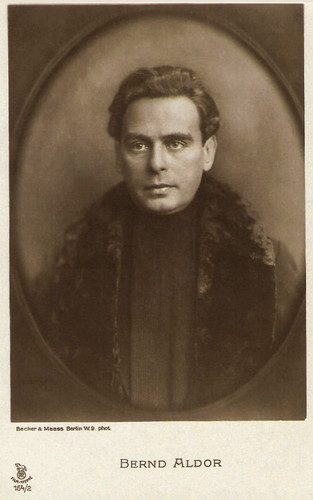
German postcard in the Film Sterne series by Rotophot., no. 164/2. Photo: Becker & Maass, Berlin.
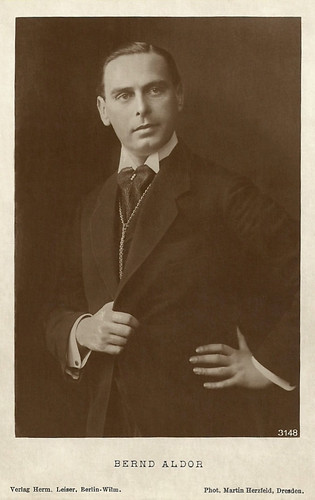
German postcard by Verlag Hermann Leiser, Berlin-Wilm., no. 3148. Photo: Martin Herzfeld, Dresden.
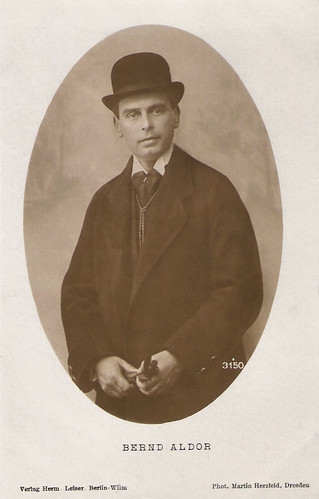
German postcard by Verlag Hermann Leiser, Berlin-Wilm., no. 3150. Photo: Martin Herzfeld, Dresden.
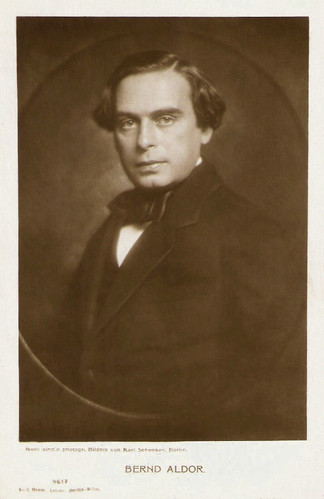
German postcard by Verlag Hermann Leiser, Berlin-Wilm., no. 3617. Photo: Karl Schenker, Berlin.
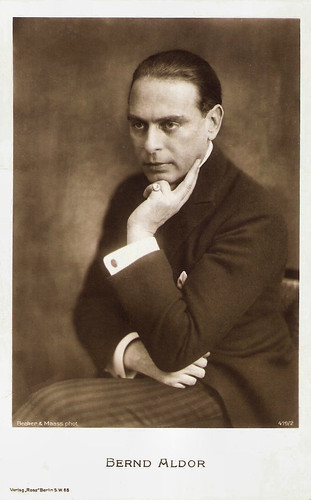
German postcard by Ross Verlag, Berlin, no. 419/2, 1919-1924. Photo: Becker & Maass.
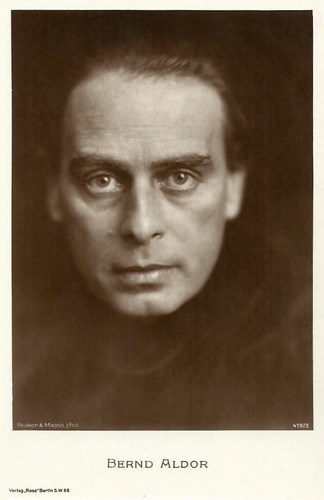
German postcard by Ross Verlag, no. 419/3, 1919-1924. Photo: Becker & Maass, Berlin.
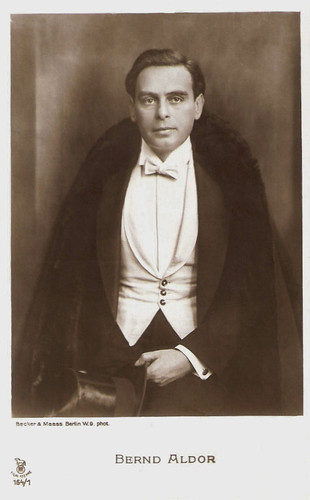
German postcard in the Film Sterne series by Rotophot, Berlin, no. 164/1. Photo: Becker & Maass, Berlin.
Sources: Thomas Staedeli (Cyranos), Filmportal.de, Wikipedia (German), and .

German postcard by Verlag Hermann Leiser, Berlin, no. 3028.

German postcard by Photochemie, no. K.1419. Photo: Alex Binder, Berlin.

German postcard by Photochemie, Berlin, no. K.2854. Photo: Rexfilm. Bernd Aldor in Der Weltspiegel/The World Mirror (Lupu Pick, 1918).

German postcard by Verlag Hermann Leiser, Berlin, no. 3151. Photo: Richard-Oswald-Produktion. Bernd Aldor as Dorian Gray in Das Bildnis des Dorian Gray/The Picture of Dorian Gray (Richard Oswald, 1917), an adaptation of Oscar Wilde's novel The Picture of Dorian Gray.

German postcard by Verlag Herman Leiser, Berlin, no. 5408. Photo: Bernd Aldor in Der Weg ins Freie/The way to the outdoors (Richard Oswald, 1918).
Aufklärungsfilme
Bernd Aldor was born in Constantinople, the former Ottoman Empire (now Istanbul, Turkey) in 1881 ( IMDb and Filmportal.de write wrongly 1887).
Shortly before the turn of the century he took acting lessons in Vienna at the master class of Karl Arnau. He began his theatrical career as an extra at the Hofburgtheater, the later Burgtheater.
In 1900 he received his first permanent engagement in Znaim (Znojmo). From 1903 on his other theatre stations included Czernowitz, Trier, Bremen, Königsberg, Leipzig, Dresden and Hamburg.
In 1906 he came to Berlin to work at the Schiller Theater. During a performance of Leo Tolstoy's The Living Corpse at the Schauspielhaus Leipzig he was discovered for the film by Charles Decroix.
His film debut was probably the German short film Die Czernowska/That Czernowska Woman (Charles Decroix, 1913), of which scenes were edited in Lyrisch Nitraat/Lyrical Nitrate (Peter Delpeut, 1991).
Other films he made with Decroix were Der Fleck/The Stain (Charles Decroix, 1913) starring Wolfgang Neff, and Das Ave Maria/The Ave Maria (Charles Decroix, 1913) opposite Fern Andra, the great American diva of the German silent cinema.
Aldor appeared also opposite another silent film diva, Henny Porten , in Die große Sünderin/The Great Sinner (Curt A. Stark, 1914), and with the young deceased Dorrit Weixler in Aschenbrödelchen/Little Cinderella (1915).
During WWI, he worked with director Richard Oswald for the first time, at Zirkusblut/Circus Blood (Richard Oswald, 1916) and at Seine letzte Maske/His last mask (Richard Oswald, 1916). In both films he played the lead role, like in most of his films during this period.
Aldor became well-known with his performances in the first two parts of a trilogy of Aufklärungsfilme (typical German educational films), Es werde Licht/There Will Be Light (Richard Oswald, 1917-1918). He played Dr. Mauthner, head of an institution for children suffering from syphilis.
He also appeared in Oswald's literary film adaptations Das Bildnis des Dorian Gray/The Picture of Dorian Gray (Richard Oswald, 1917) based on the classic novel by Oscar Wilde, and Tolstoy's Der lebende Leichnam/The Living Corpse (Richard Oswald, 1918), which he had earlier performed on stage.
From 1917 to 1919 he was also the star of several film by actor-writer-director Lupu Pick, such as Die Liebe des Van Royk/The Love of Van Royk (Lupu Pick, 1918), Der Weltspiegel/The Mirror World (Lupu Pick, 1918) and Mein Wille ist Gesetz/My will is law (Lupu Pick, 1919) with Olga Engl.

German postcard by Hermann Leiser Verlag, Berlin, no. 3152. Photo: Richard-Oswald-Produktion. Bernd Aldor in Das Bildnis des Dorian Gray (Richard Oswald, 1917), an adaptation of Oscar Wilde's The Picture of Dorian Gray.

German postcard by Verlag Hermann Leiser, Berlin, no. 3153. Photo: Richard Oswald-Film. Bernd Aldor in Der Schloßherr von Hohenstein/The manor of Hohenstein (Richard Oswald, 1917).

German postcard by Verlag Hermann Leiser, Berlin, no. 3154. Photo: Richard Oswald-Film. Bernd Aldor playing the violin in the German silent film Der Schloßherr von Hohenstein/The manor of Hohenstein (Richard Oswald, 1917).

German postcard in the Bernd Aldor Series 1917/1918 III. by Verlag Herman Leiser, Berlin-Wilm. Phot: Richard Oswald Film. Bernd Aldor in Der Weg ins Freie (Richard Oswald, 1918).

German postcard by Photochemie, Berlin, no. K.2853. Bernd Aldor in Der Weltspiegel/The World Mirror (Lupu Pick, 1918). The woman could be Gertrud Welcker.

German postcard by Photochemie, Berlin, K.2855. Photo: Rexfilm. Bernd Aldor in Die Liebe des van Royk/The Love of van Royk (Lupu Pick, 1917). Though the woman right of Aldor looks like Ria Jende, she is not named among the actresses in Filmportal.de. the postcard names the character von Royk instead of van Royk.

German postcard Photochemie, Berlin, no. K.2856. Photo: Rexfilm. Bernd Aldor in Die tolle Heirat von Laló/The great marriage of Laló (Lupu Pick, 1918).
Oblivion
Until the mid-1920s, Bernd Aldor was seen in leading roles. He starred as Talma opposite Fern Andra again in Madame Récamier (Joseph Delmont, 1920). In the drama Die Furcht vor dem Weibe/The fear of the woman (Hanna Henning, 1921) he starred opposite Otto Gebühr .
He appeared at the side of the great comedian Hermann Valentin in Graf Cohn/Count Cohn (Carl Boese, 1923), and with Claire Rommer in Aschermittwoch/Ash Wednesday (1925), directed by his old co-star Wolfgang Neff, who had turned into a director.
He reunited with Oswald for Halbseide/Half silk (Richard Oswald, 1925) as the husband of Mary Parker .
From 1927 on his film parts became smaller. He played supporting parts in Die glühende Gasse/The glowing alley (Paul Sugar, 1927) starring Hans Albers , the comedy Schwere Jungs - leichte Mädchen/Guys and Dolls (Carl Boese, 1927) starring Gustav Fröhlich and Lissi Arna , and Indizienbeweis/Circumstantial evidence (Georg Jacoby, 1929) starring Fritz Alberti.
Then he slowly fell into oblivion, but he did some small film appearances in the sound era. Richard Oswald gave him a small part in his sound film Dreyfus (Richard Oswald, 1930) starring Fritz Kortner and Heinrich George .
His final film appearance was in Elisabeth von Österreich/Elisabeth of Austria (Adolf Trotz, 1931) starring Lil Dagover . In 1932, Aldor was committed by the Romanian actor Constantin Tanase to direct a film in Berlin, Visul lui Tanase/Tanase's Dream (Bernd Aldor, 1932).
In July 1938, he was excluded from the Reichsfilmkammer because of his "probably not Aryan" origin, although he had not been active for the cinema since 1932. Maybe the Jewish Bernd Aldor had fled the country. There is no information about him during this period.
Wikipedia writes that only in 1950 he and his wife Hilde were 'detected' again, now in Vienna, Austria. A little later the former actor died there, in 1950. He was 69.

German postcard by NPG (Neue Photographische Gesellschaft), no. 811. Photo: Anny Eberth, Berlin.

German postcard in the Film Sterne series by Rotophot., no. 164/2. Photo: Becker & Maass, Berlin.

German postcard by Verlag Hermann Leiser, Berlin-Wilm., no. 3148. Photo: Martin Herzfeld, Dresden.

German postcard by Verlag Hermann Leiser, Berlin-Wilm., no. 3150. Photo: Martin Herzfeld, Dresden.

German postcard by Verlag Hermann Leiser, Berlin-Wilm., no. 3617. Photo: Karl Schenker, Berlin.

German postcard by Ross Verlag, Berlin, no. 419/2, 1919-1924. Photo: Becker & Maass.

German postcard by Ross Verlag, no. 419/3, 1919-1924. Photo: Becker & Maass, Berlin.

German postcard in the Film Sterne series by Rotophot, Berlin, no. 164/1. Photo: Becker & Maass, Berlin.
Sources: Thomas Staedeli (Cyranos), Filmportal.de, Wikipedia (German), and .
Published on December 04, 2019 22:00
December 3, 2019
Edwige Feuillère
Charming and elegant Edwige Feuillère (1907-1998) was during the 1940s the ‘First Lady’ of the French cinema. Edwige was known for the ease in which she could switch from playing sophisticated sexy ladies and cruel, self-centred seductresses. For more than sixty years she stayed a beloved ‘vedette’ of the French stage and screen.
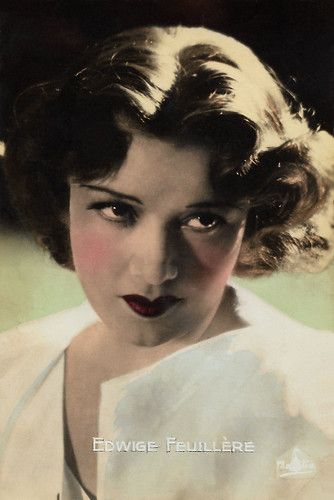
French collectors card by Massilia.
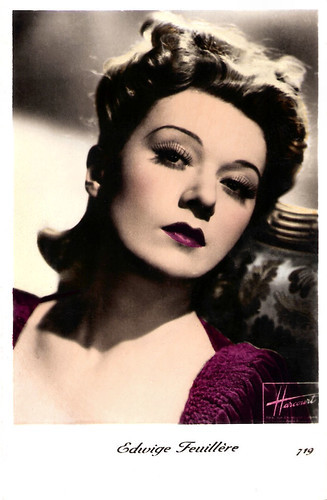
French postcard by Editions P.I., Paris, no. 719. Photo: Studio Harcourt.
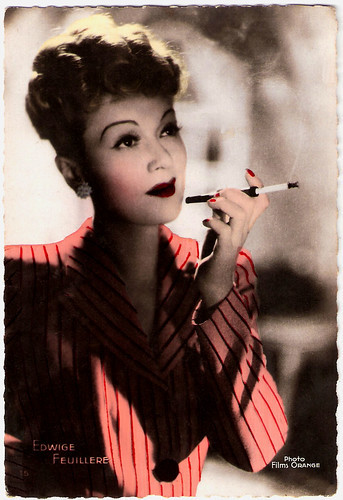
French postcard by Editions P.I., Paris, no. 15. Photo: Films Orange. Edwige Feuillère in L'honorable Catherine/The Honourable Catherine (Marcel L'Herbier, 1943).
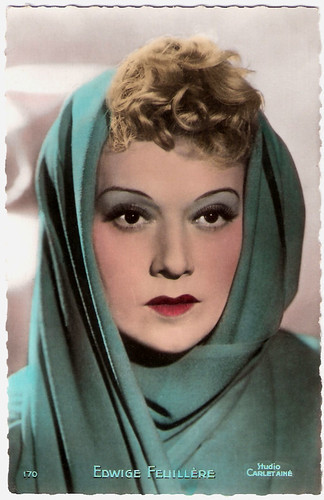
French postcard by Editions P.I., no. 170. Photo: Studio Carlet Ainé.
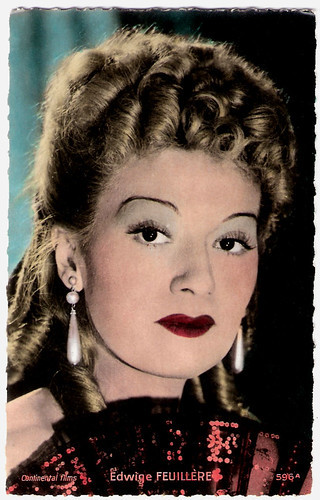
French postcard by Edit. Chantal, Rueil, no. 596 A. Photo: Continental Films.
Camille
Edwige Feuillère was born Edwige Louise Caroline Cunati in Vesoul, in the Haute-Saône in eastern France in 1907. Her father was Italian and, because he was drafted by the Italian army in World War I, Edwige spent much of her childhood in Italy.
After the war, the family moved to Dijon in France. Edwige attended the lyceum in Dijon where she acted in plays including Jean Racine's plays 'Esther' and 'Athalie'. At the Dijon Conservatoire she studied diction, interpretation of character and singing, and easily passed the entrance exam for the Paris Conservatoire in 1928.
Two years later, she won the first prize for comedy. She married an older fellow student, Pierre Feuillere, but he proved to be a drug addict who used to play suicidal games with her.
She made her theatrical debut under the stage name Cora Lynn, playing small roles in 1930. In 1931 she became a member of the Comédie Française, and made her debut in Pierre Beaumarchais' comedy 'Le Mariage de Figaro'. In 1933, Edwige left both the troupe and her husband, but she kept his surname.
During the 1930s and 1940s, the stunningly beautiful actress became one of the leading ladies of the French stage. A success was her role in Édouard Bourdet's 'La Prisonniere' (The Captive) in 1935 at the Théâtre Heberthot. The play had a long run and was frequently revived. Among her most popular roles was also Marguerite Gautier in 'La Dame aux camélias' (Camille) by Alexandre Dumas fils (1939-1942).
For the next two decades she appeared in frequent revivals of 'La Dame aux camélias' in France and Britain. Another triumph was 'Sodome et Gomorrhe' (Sodom and Gomorrah) by modern author Jean Giraudoux (1943), for which she helped to discover Gérard Philipe .
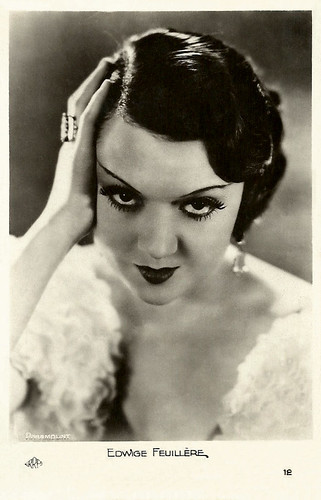
French postcard by Erres, no. 12. Photo: Paramount.
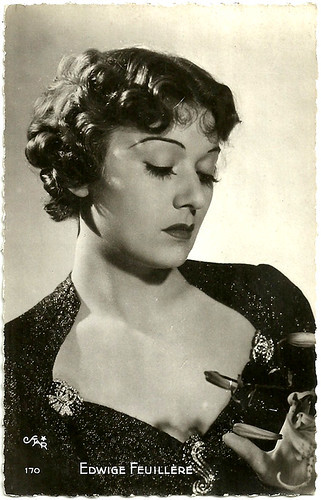
French postcard, no. 170. Photo: Star.
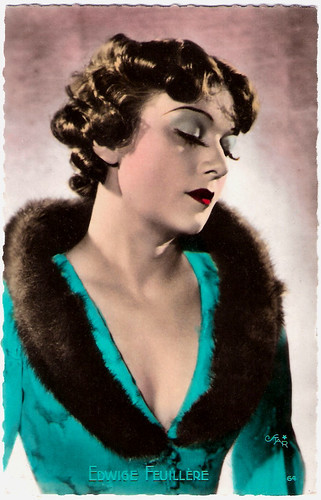
French postcard by Editions O.P., Paris, no. 64. Photo: Star.
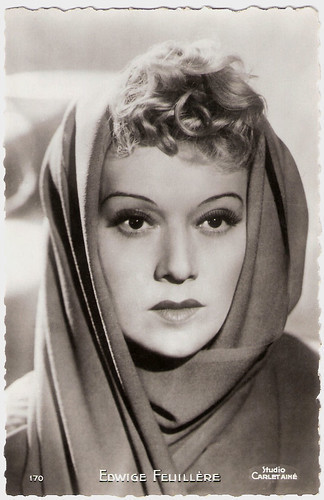
French postcard by Editions P.I., no. 170. Photo: Studio Carlet Ainé.
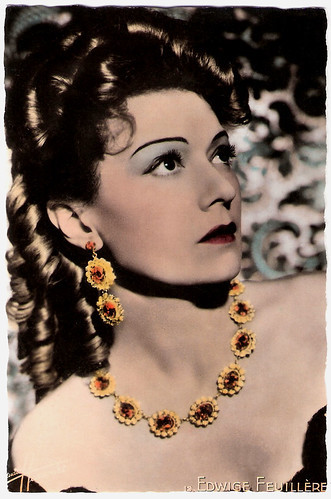
French postcard by Greff / S.E.R.P. Editeur, Paris, no. 596 A. Photo: Continental Films.
Nude Scene
Edwige Feuillère's first film appearance was in the short La Fine combine/The Fine combines (André Chotin, 1931) opposite Fernandel , and her feature debut was in Le Cordon bleu/The Champion Cook (Alberto Cavalcanti, Karl Anton, 1931). For both films she still used the name Cora Lynn.
Louis Gasnier cast her in the first film version of the farce Topaze (1933), based on the play by Marcel Pagnol. Her charm and elegance opposite Louis Jouvet were widely appreciated.
In the strait-laced Europe of 1935, she scandalised the public with a brief nude scene in Lucrèce Borgia/Lucrezia Borgia (Abel Gance, 1935). This historical drama in which she played her first leading role, solidified her popularity. That year she also appeared in the epic Golgotha/Behold the Man (Julien Duvivier, 1935) starring Harry Baur and Jean Gabin , and in the Ufa production Barcarolle (Gerhard Lamprecht, Roger Le Bon, 1935), the French-language version of Lamprecht's Barcarole (1935).
Her roles as elegant and often heartless women were displayed in Mister Flow/Compliments of Mr. Flow (Robert Siodmak, 1936), Marthe Richard au service de la France/Marthe Richard (Raymond Bernard, 1937) as a charming spy opposite Erich von Stroheim , La Dame de Malacca/Woman of Malacca (Marc Allégret, 1937), and J'étais une aventurière/I Was an Adventuress (Raymond Bernard, 1938).
She went on working with famous director Max Ophüls in the melodrama Sans lendemain/Without Tomorrow (1939) in which she gave a wonderful performance as a jaded woman, abandoned by a shady husband with a lot of debts, who is sacrified, and in De Mayerling à Sarajévo/Mayerling to Sarajevo (1940) about the liaison between Archduke Franz Ferdinand - unwilling heir to the Habsburg throne - and his wife, Countess Sophie Chotek. The film ends with the couple's assassination by a Serb terrorist in 1914, and thus starting WW I. Work on this film began in 1939 and was interrupted by the war. It was finished in the spring of 1940, only to be banned by the Germans. The first ‘official’ premiere was on 18 May 1945.
Feuillères next film, Mam'zelle Bonaparte/Miss Bonaparte (Maurice Tourneur, 1941) became a popular success, although IMDb calls the film a ‘dud’. Another success was her role as a coquette caught by a great love for Pierre Richard-Willm in La Duchesse de Langeais/Wicked Duchess (Jacques de Baroncelli, 1941) based on a novel by Honoré de Balzac with dialogues by Jean Giraudoux. Worth watching is also the romantic screwball comedy L'Honorable Catherine/The Honourable Catherine (Marcel L’Herbier, 1943) with Feuillère as a high society blackmailer whose latest blackmail attempt is interrupted, and she has to pose as her victim’s lover.
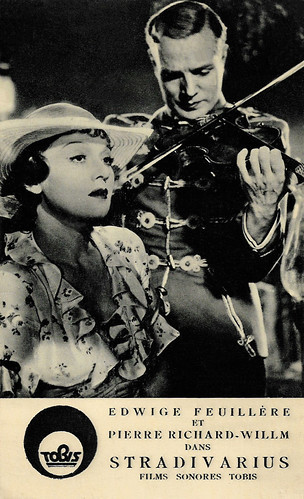
French postcard by Tobis. Photo: Edwige Feuillère and Pierre Richard-Willm in Stradivarius (Albert Valentin, Géza von Bolváry, 1935).
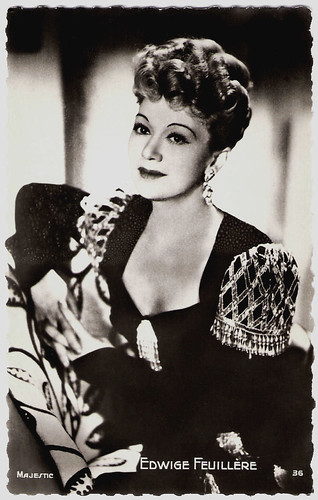
French postcard by Editions P.I., La Garenne-Colombes, no. 36. Photo: Majestic.
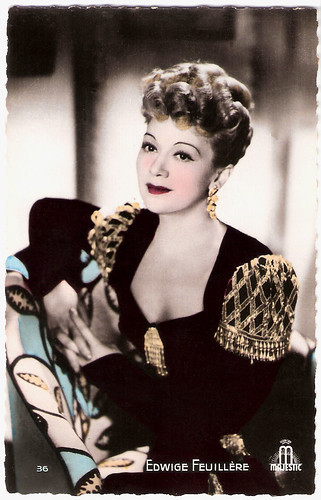
French postcard by Editions P.I., La Garenne-Colombes, no. 36. Photo: Majestic.
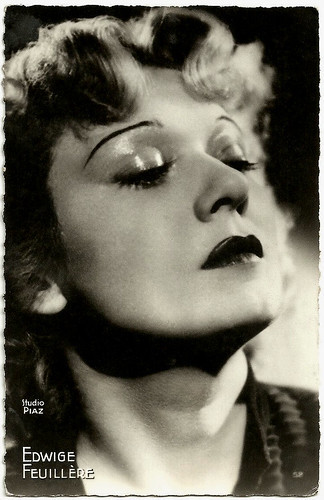
French postcard by Editions P.I., Paris, no. 52. Photo: Studio Paz.
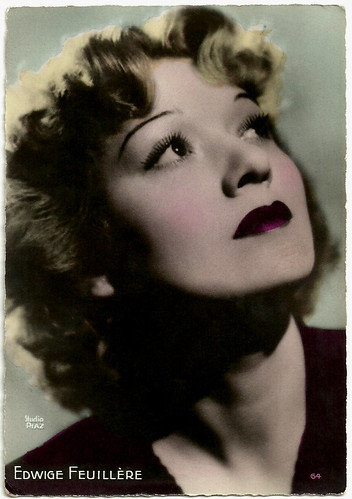
French postcard by Editions P.I., Paris, no. 64. Photo: Studio Paz.
Magnetic Presence
By the mid-1940s Edwige Feuillère had become a distinguished actress, respected for her powerful well-modulated voice, expressive eyes and magnetic presence. She was frequently acclaimed for her interpretation of classical stage roles. She turned down a seven-year Hollywood contract offered by Louis B. Mayer in 1945 and tended to make fewer films after the war. Her stage performances made her even more appreciated in films when she made them.
With Gérard Philipe she appeared in the Fyodor Dostoyevsky film adaptation L’Idiot/The Idiot (Georges Lampin, 1946).
She did 200 performances of Jean Cocteau's 'L'Aigle à deux têtes' (The Eagle with Two Heads) as the widowed queen who falls in love with a political fugitive played by Jean Marais . The role was especially written for Feuillère by Cocteau, and she also starred in the screen version, L'Aigle à deux têtes (Jean Cocteau, 1947).
She played more great screen roles like the title character in Julie de Carneilhan (Jacques Manuel, 1949), and as the older woman introducing an adolescent to love in Le Blé en herbe/The Game of Love (Claude Autant-Lara, 1954), based on Colette 's novel. Her role in this film was a scandal, even though Feuillère was brilliant and the writer kept out any suggestion of prurience.
Other great films of this decade were Olivia/The Pit of Loneliness (Jacqueline Audry, 1950) nominated with a BAFTA Film Award, Adorables Créatures/Adorable Creatures (Christian-Jaque, 1952) in which she played an eccentric bourgeoise who discovers the arcane delights of a banal sandwich, and the crime drama En cas de malheur/Love Is My Profession (Claude Autant-Lara, 1958) with Jean Gabin and Brigitte Bardot.
Another major stage role, which she would also perform again and again, was the femme fatale Yse opposite Jean-Louis Barrault in Paul Claudel's 'Partage de midi'. In 1951 she made her first - and reportedly unforgettable - London stage appearance with this long and difficult role for the Renaud-Barrault company. In 1955 she returned to London for a season with La Dame aux Camélias and other plays. In 1968, when she appeared again in London in 'Partage de midi', the British theatre critic Harold Hobson described her as 'the greatest actress he had ever seen'.
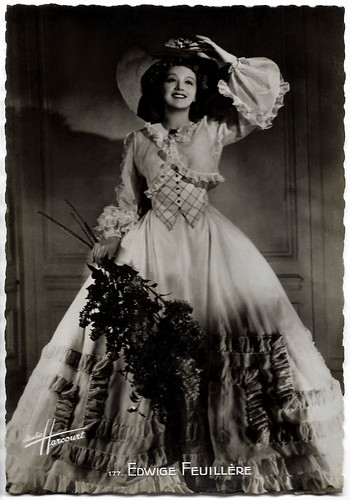
French postcard by S.E.R.P., Paris, no. 177. Photo: Studio Harcourt.
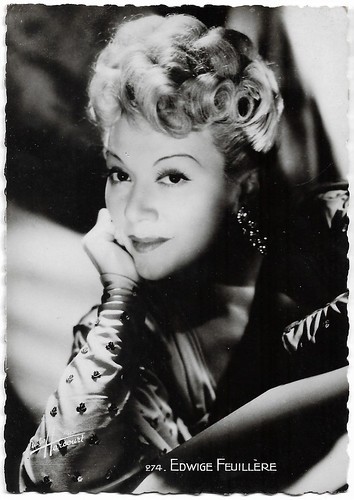
French postcard, no. 274. Photo: Studio Harcourt.
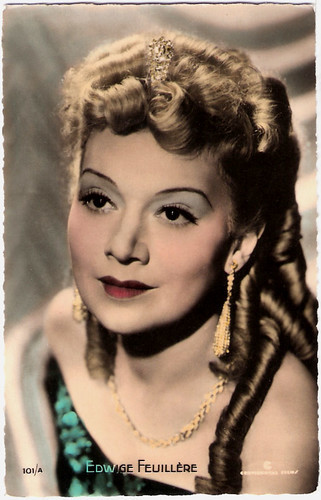
French postcard by Editions Continental, no. 101 A. Photo: Continental Films.
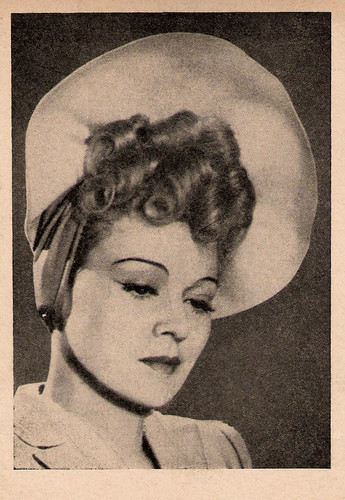
German postcard.
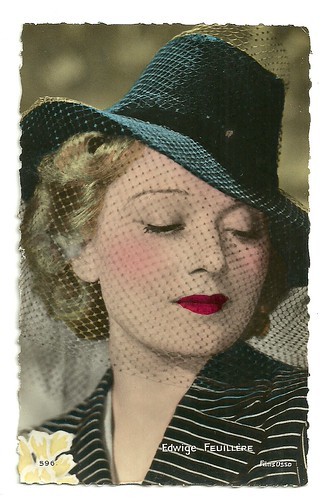
French postcard by Ed. Chantal, Paris, no. 596. Photo: Films Osso.
Gracefully Elegant Grande Dame
In the 1960s and 1970s, Edwige Feuillère appeared often on stage, such as in 1965 in 'La folle de Chaillot' (The Madwoman of Chaillot) by Jean Giraudoux. She later reprised this role on television, La folle de Chaillot (Gérard Vergez, 1976). According to IMDb her nickname was ‘Edwige 1ère’ (Edwige the 1st) for her cool and rather imposing acting style. She was equally at home playing in dramas and comedies.
She also continued to be a popular film and television actress and worked with directors of the next generations like Michel Boisrond in an episode of Amours célèbres/Famous Love Affairs (1961) and Roman Polanski, who wrote the script for the dark cannibal comedy Aimez-vous les Femmes/A Taste for Women (Jean Léon, 1963). She showed little interest in a glamorous life style. Modest and humorous in private, she was also self-deprecating about her talent in her 1977 autobiography, 'Les Feux de la Memoire' (The Fires of Memory).
One of the best of her later films was La chair de l'orchidée/The Flesh of the Orchid (Patrice Chéreau – his film debut, 1975) starring Charlotte Rampling . In this crime drama, based on James Hadley Chase's 'No Orchids for Miss Blandish', Edwige Feuillère appeared disturbingly out of character. Another interesting film was the TV film Le tueur triste/The Sad Killer (Nicolas Gessner, 1984), in which she appeared as the grandmother.
In 1984 she was awarded an honorary César. She continued to act onstage and in the occasional film until her official retirement in 1992. Her last stage performance was 'Edwige Feuillère en Scène', in which she replayed scenes from her most famous roles and told about her long career. TV broadcaster ARTE made a documentary of it, Edwige Feuillère en scène (Serge Moati, 1993). In 1993 she was named 'Commandeur des Arts et Lettres; Grand Officier de la Légion d'Honneur'. That same year she was also awarded the Molière prize for her stage work. The gracefully elegant 'grande dame' played her last role in the TV film La Duchesse de Langeais/The Dutchess of Langeais (Jean-Daniel Verhaeghe, 1995).
Edwige Feuillère died of natural causes in 1998 in Boulogne-Billancourt, Île-de-France. She was 91. After her death Le Monde wrote: "Edwige Feuillere was our Marlene Dietrich , our Irene Dunne and our Greta Garbo , all in one."
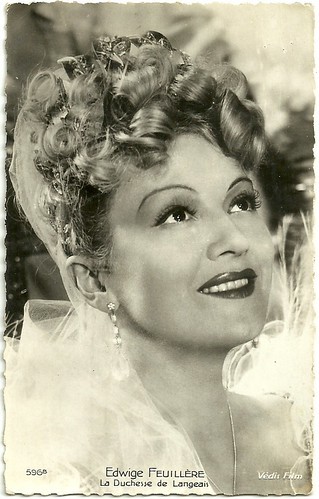
French postcard, no. 596 B. Photo: Védis Film. Edwige Feuillère in La Duchesse de Langeais (Jacques de Baroncelli, 1942).
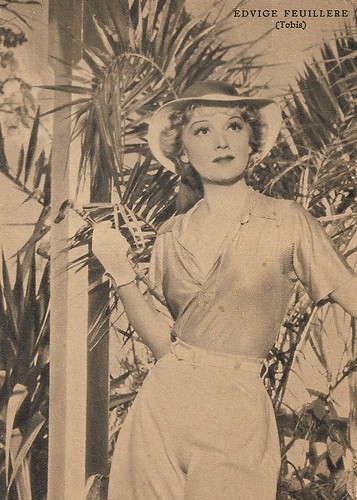
Italian postcard by Rizzoli. Photo: Tobis.
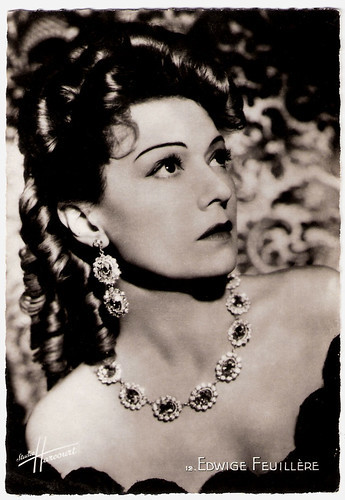
French postcard by S.E.R.P., Paris, no. 12. Photo: Studio Harcourt.
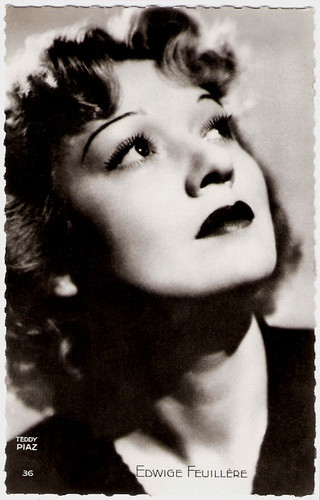
French postcard by Editions P.I., Paris, no. 36. Photo: Teddy Piaz.
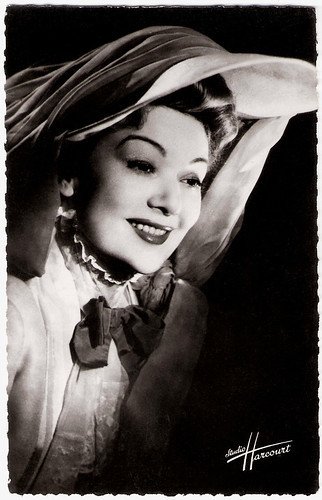
French postcard by Editions O.P., Paris, no. 106. Photo: Studio Harcourt.
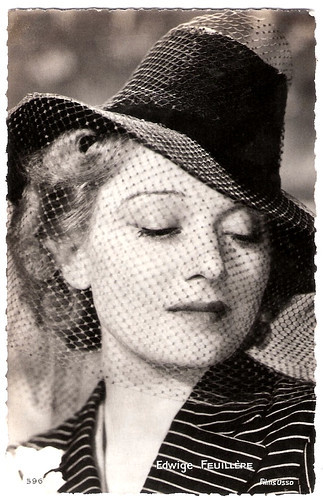
French postcard by Ed. Chantal, Paris, no. 596. Photo: Films Osso.
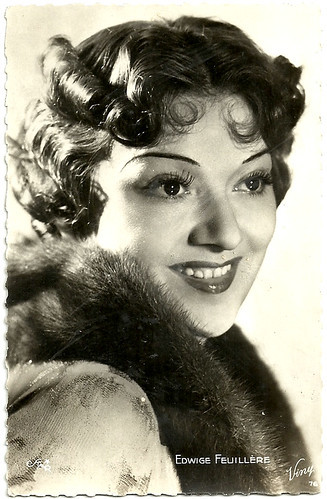
French postcard by Viny, no. 46. Photo: Star.
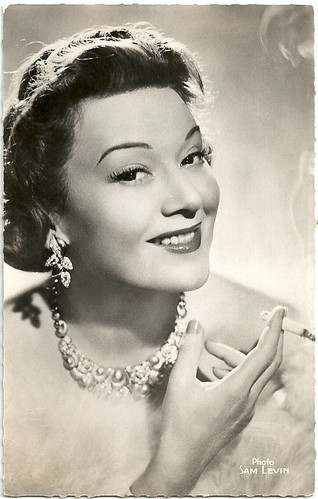
French postcard. Photo: Sam Lévin.
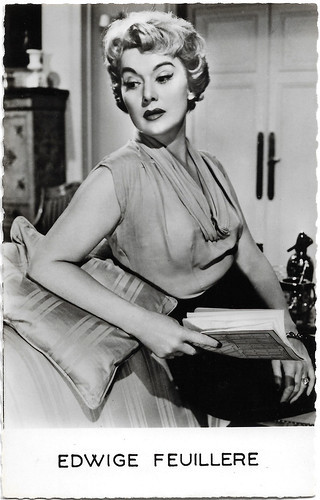
French postcard by Editions P.I., Paris, no. S-1000 18K.
Sources: Karel Tabery (Filmreference.com), Sandra Brennan (AllMovie), Alan Riding (The New York Times), John Calder (The Independent), Wikipedia, and .

French collectors card by Massilia.

French postcard by Editions P.I., Paris, no. 719. Photo: Studio Harcourt.

French postcard by Editions P.I., Paris, no. 15. Photo: Films Orange. Edwige Feuillère in L'honorable Catherine/The Honourable Catherine (Marcel L'Herbier, 1943).

French postcard by Editions P.I., no. 170. Photo: Studio Carlet Ainé.

French postcard by Edit. Chantal, Rueil, no. 596 A. Photo: Continental Films.
Camille
Edwige Feuillère was born Edwige Louise Caroline Cunati in Vesoul, in the Haute-Saône in eastern France in 1907. Her father was Italian and, because he was drafted by the Italian army in World War I, Edwige spent much of her childhood in Italy.
After the war, the family moved to Dijon in France. Edwige attended the lyceum in Dijon where she acted in plays including Jean Racine's plays 'Esther' and 'Athalie'. At the Dijon Conservatoire she studied diction, interpretation of character and singing, and easily passed the entrance exam for the Paris Conservatoire in 1928.
Two years later, she won the first prize for comedy. She married an older fellow student, Pierre Feuillere, but he proved to be a drug addict who used to play suicidal games with her.
She made her theatrical debut under the stage name Cora Lynn, playing small roles in 1930. In 1931 she became a member of the Comédie Française, and made her debut in Pierre Beaumarchais' comedy 'Le Mariage de Figaro'. In 1933, Edwige left both the troupe and her husband, but she kept his surname.
During the 1930s and 1940s, the stunningly beautiful actress became one of the leading ladies of the French stage. A success was her role in Édouard Bourdet's 'La Prisonniere' (The Captive) in 1935 at the Théâtre Heberthot. The play had a long run and was frequently revived. Among her most popular roles was also Marguerite Gautier in 'La Dame aux camélias' (Camille) by Alexandre Dumas fils (1939-1942).
For the next two decades she appeared in frequent revivals of 'La Dame aux camélias' in France and Britain. Another triumph was 'Sodome et Gomorrhe' (Sodom and Gomorrah) by modern author Jean Giraudoux (1943), for which she helped to discover Gérard Philipe .

French postcard by Erres, no. 12. Photo: Paramount.

French postcard, no. 170. Photo: Star.

French postcard by Editions O.P., Paris, no. 64. Photo: Star.

French postcard by Editions P.I., no. 170. Photo: Studio Carlet Ainé.

French postcard by Greff / S.E.R.P. Editeur, Paris, no. 596 A. Photo: Continental Films.
Nude Scene
Edwige Feuillère's first film appearance was in the short La Fine combine/The Fine combines (André Chotin, 1931) opposite Fernandel , and her feature debut was in Le Cordon bleu/The Champion Cook (Alberto Cavalcanti, Karl Anton, 1931). For both films she still used the name Cora Lynn.
Louis Gasnier cast her in the first film version of the farce Topaze (1933), based on the play by Marcel Pagnol. Her charm and elegance opposite Louis Jouvet were widely appreciated.
In the strait-laced Europe of 1935, she scandalised the public with a brief nude scene in Lucrèce Borgia/Lucrezia Borgia (Abel Gance, 1935). This historical drama in which she played her first leading role, solidified her popularity. That year she also appeared in the epic Golgotha/Behold the Man (Julien Duvivier, 1935) starring Harry Baur and Jean Gabin , and in the Ufa production Barcarolle (Gerhard Lamprecht, Roger Le Bon, 1935), the French-language version of Lamprecht's Barcarole (1935).
Her roles as elegant and often heartless women were displayed in Mister Flow/Compliments of Mr. Flow (Robert Siodmak, 1936), Marthe Richard au service de la France/Marthe Richard (Raymond Bernard, 1937) as a charming spy opposite Erich von Stroheim , La Dame de Malacca/Woman of Malacca (Marc Allégret, 1937), and J'étais une aventurière/I Was an Adventuress (Raymond Bernard, 1938).
She went on working with famous director Max Ophüls in the melodrama Sans lendemain/Without Tomorrow (1939) in which she gave a wonderful performance as a jaded woman, abandoned by a shady husband with a lot of debts, who is sacrified, and in De Mayerling à Sarajévo/Mayerling to Sarajevo (1940) about the liaison between Archduke Franz Ferdinand - unwilling heir to the Habsburg throne - and his wife, Countess Sophie Chotek. The film ends with the couple's assassination by a Serb terrorist in 1914, and thus starting WW I. Work on this film began in 1939 and was interrupted by the war. It was finished in the spring of 1940, only to be banned by the Germans. The first ‘official’ premiere was on 18 May 1945.
Feuillères next film, Mam'zelle Bonaparte/Miss Bonaparte (Maurice Tourneur, 1941) became a popular success, although IMDb calls the film a ‘dud’. Another success was her role as a coquette caught by a great love for Pierre Richard-Willm in La Duchesse de Langeais/Wicked Duchess (Jacques de Baroncelli, 1941) based on a novel by Honoré de Balzac with dialogues by Jean Giraudoux. Worth watching is also the romantic screwball comedy L'Honorable Catherine/The Honourable Catherine (Marcel L’Herbier, 1943) with Feuillère as a high society blackmailer whose latest blackmail attempt is interrupted, and she has to pose as her victim’s lover.

French postcard by Tobis. Photo: Edwige Feuillère and Pierre Richard-Willm in Stradivarius (Albert Valentin, Géza von Bolváry, 1935).

French postcard by Editions P.I., La Garenne-Colombes, no. 36. Photo: Majestic.

French postcard by Editions P.I., La Garenne-Colombes, no. 36. Photo: Majestic.

French postcard by Editions P.I., Paris, no. 52. Photo: Studio Paz.

French postcard by Editions P.I., Paris, no. 64. Photo: Studio Paz.
Magnetic Presence
By the mid-1940s Edwige Feuillère had become a distinguished actress, respected for her powerful well-modulated voice, expressive eyes and magnetic presence. She was frequently acclaimed for her interpretation of classical stage roles. She turned down a seven-year Hollywood contract offered by Louis B. Mayer in 1945 and tended to make fewer films after the war. Her stage performances made her even more appreciated in films when she made them.
With Gérard Philipe she appeared in the Fyodor Dostoyevsky film adaptation L’Idiot/The Idiot (Georges Lampin, 1946).
She did 200 performances of Jean Cocteau's 'L'Aigle à deux têtes' (The Eagle with Two Heads) as the widowed queen who falls in love with a political fugitive played by Jean Marais . The role was especially written for Feuillère by Cocteau, and she also starred in the screen version, L'Aigle à deux têtes (Jean Cocteau, 1947).
She played more great screen roles like the title character in Julie de Carneilhan (Jacques Manuel, 1949), and as the older woman introducing an adolescent to love in Le Blé en herbe/The Game of Love (Claude Autant-Lara, 1954), based on Colette 's novel. Her role in this film was a scandal, even though Feuillère was brilliant and the writer kept out any suggestion of prurience.
Other great films of this decade were Olivia/The Pit of Loneliness (Jacqueline Audry, 1950) nominated with a BAFTA Film Award, Adorables Créatures/Adorable Creatures (Christian-Jaque, 1952) in which she played an eccentric bourgeoise who discovers the arcane delights of a banal sandwich, and the crime drama En cas de malheur/Love Is My Profession (Claude Autant-Lara, 1958) with Jean Gabin and Brigitte Bardot.
Another major stage role, which she would also perform again and again, was the femme fatale Yse opposite Jean-Louis Barrault in Paul Claudel's 'Partage de midi'. In 1951 she made her first - and reportedly unforgettable - London stage appearance with this long and difficult role for the Renaud-Barrault company. In 1955 she returned to London for a season with La Dame aux Camélias and other plays. In 1968, when she appeared again in London in 'Partage de midi', the British theatre critic Harold Hobson described her as 'the greatest actress he had ever seen'.

French postcard by S.E.R.P., Paris, no. 177. Photo: Studio Harcourt.

French postcard, no. 274. Photo: Studio Harcourt.

French postcard by Editions Continental, no. 101 A. Photo: Continental Films.

German postcard.

French postcard by Ed. Chantal, Paris, no. 596. Photo: Films Osso.
Gracefully Elegant Grande Dame
In the 1960s and 1970s, Edwige Feuillère appeared often on stage, such as in 1965 in 'La folle de Chaillot' (The Madwoman of Chaillot) by Jean Giraudoux. She later reprised this role on television, La folle de Chaillot (Gérard Vergez, 1976). According to IMDb her nickname was ‘Edwige 1ère’ (Edwige the 1st) for her cool and rather imposing acting style. She was equally at home playing in dramas and comedies.
She also continued to be a popular film and television actress and worked with directors of the next generations like Michel Boisrond in an episode of Amours célèbres/Famous Love Affairs (1961) and Roman Polanski, who wrote the script for the dark cannibal comedy Aimez-vous les Femmes/A Taste for Women (Jean Léon, 1963). She showed little interest in a glamorous life style. Modest and humorous in private, she was also self-deprecating about her talent in her 1977 autobiography, 'Les Feux de la Memoire' (The Fires of Memory).
One of the best of her later films was La chair de l'orchidée/The Flesh of the Orchid (Patrice Chéreau – his film debut, 1975) starring Charlotte Rampling . In this crime drama, based on James Hadley Chase's 'No Orchids for Miss Blandish', Edwige Feuillère appeared disturbingly out of character. Another interesting film was the TV film Le tueur triste/The Sad Killer (Nicolas Gessner, 1984), in which she appeared as the grandmother.
In 1984 she was awarded an honorary César. She continued to act onstage and in the occasional film until her official retirement in 1992. Her last stage performance was 'Edwige Feuillère en Scène', in which she replayed scenes from her most famous roles and told about her long career. TV broadcaster ARTE made a documentary of it, Edwige Feuillère en scène (Serge Moati, 1993). In 1993 she was named 'Commandeur des Arts et Lettres; Grand Officier de la Légion d'Honneur'. That same year she was also awarded the Molière prize for her stage work. The gracefully elegant 'grande dame' played her last role in the TV film La Duchesse de Langeais/The Dutchess of Langeais (Jean-Daniel Verhaeghe, 1995).
Edwige Feuillère died of natural causes in 1998 in Boulogne-Billancourt, Île-de-France. She was 91. After her death Le Monde wrote: "Edwige Feuillere was our Marlene Dietrich , our Irene Dunne and our Greta Garbo , all in one."

French postcard, no. 596 B. Photo: Védis Film. Edwige Feuillère in La Duchesse de Langeais (Jacques de Baroncelli, 1942).

Italian postcard by Rizzoli. Photo: Tobis.

French postcard by S.E.R.P., Paris, no. 12. Photo: Studio Harcourt.

French postcard by Editions P.I., Paris, no. 36. Photo: Teddy Piaz.

French postcard by Editions O.P., Paris, no. 106. Photo: Studio Harcourt.

French postcard by Ed. Chantal, Paris, no. 596. Photo: Films Osso.

French postcard by Viny, no. 46. Photo: Star.

French postcard. Photo: Sam Lévin.

French postcard by Editions P.I., Paris, no. S-1000 18K.
Sources: Karel Tabery (Filmreference.com), Sandra Brennan (AllMovie), Alan Riding (The New York Times), John Calder (The Independent), Wikipedia, and .
Published on December 03, 2019 22:00
December 2, 2019
Zuflucht (1928)
For the social melodrama Zuflucht (1928), Henny Porten invited stage actor Franz Lederer to be her co-star. His film debut immediately tuned the handsome Czech actor into a popular film star. Zuflucht/Refuge was produced by Porten's own film company, HPF (Henny Porten-Froelich Produktion GmbH (Berlin)), and directed by Carl Froelich. Froelich staged the film as realistically as possible by shooting in the quarters of workers, kitchens, arcades, market halls, and third-class hospitals. The cast also included Max Maximilian, Margarete Kupfer, Alice Hechy and Carl de Vogt.

German postcard by Ross Verlag, no. 100/1. Photo: Alex. Schmoll / HPF (Henny Porten-Froelich Produktion GmbH (Berlin)). Henny Porten and Franz Lederer in Zufluch/tRefuge (Carl Froelich, 1928).

German postcard by Ross Verlag, no. 100/2. Photo: Alex. Schmoll / HPF (HPF (Henny Porten-Froelich Produktion GmbH (Berlin)). Henny Porten and Franz Lederer in Zuflucht/Refuge (Carl Froelich, 1928).
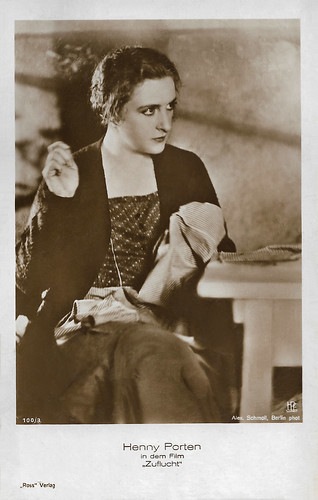
German postcard by Ross Verlag, no. 110/3. Photo: Alex. Schmoll, Berlin / HPF (Henny Porten-Froelich Produktion GmbH (Berlin)). Henny Porten in Zuflucht/Refuge (Carl Froelich, 1928).
A ray of hope
In Zuflucht/Refuge, Franz Lederer plays Martin, who has to flee Germany because of his involvement in the November Revolution. Eight years later, he returns to Berlin. The market vendor Hannelore ( Henny Porten ) offers him shelter in her apartment, whereupon both fall in love. Martin soon finds work in the construction of the north-south subway through the Tempelhof field, but collapses one day. The pregnant Hannelore cares for the seriously ill Martin.
Hal Erickson writes at AllMovie : "Best known for her comedy roles, Henny Porten went dramatic big-time in her 1928 vehicle Zufflucht [sic] (Refuge). Since Porten also produced the film, she bore the brunt of the criticism, which was far from kind. Many felt that the actress would have been better off sticking to comedy, while others were of the opinion that she was too old for her role (she was all of 40 at the time). The most positive comments were reserved for Porten's incredibly good-looking leading man, Francis Lederer . In fact, Zufflucht represented Lederer's screen debut, a full year before his 'official' cinematic bow in Pabst's Pandora's Box."
However, the film was positively received by some of the German critics at the time. The Berliner Lokal-Anzeiger reviewed the film on 1 September 1928: "The fact is that this simple story became a wonderful film, and indeed a tangible step forward in the field of German film in general - thanks not only to the exquisite portrayal, but above all to the direction of the film. Carl Froelich has had the courage to openly show what he has learned from the New Russian film art. [...]
There is hardly any tradition here, there is no bashful make-up, nothing and nobody is made 'cute' - yes, the outstanding Henny Porten does not even shy away from turning into a self-denying Cinderella. That sounds hard, but it means liberation from the traditional teasing fuss of numerous film divas, numerous directors. [...] The film is a ray of hope. "
Critic Hanns Horkheimer added in Berliner Tageblatt on 2 September 1928: "The good role of her Hanne is raised to all-human validity, when this joyless market maid awakens to motherly-loving sacrifice, when she, the tormented, with two powerful arms, makes a new life for the strayed, and then when the short spring is full of warmth and heat Promise on the deathbed of the selfless lover forever vanishes. This lover is Franz Lederer , [...] as a film debutant of the antics of Russian film actors. Naturalistic life and experience are raised by him through creative skill into that sphere in which there are no bravura details, but only a self-evident whole. The management of the again tactically, technically and figuratively very hard-working and skillful Carl Froelich contributed the rest to the success."
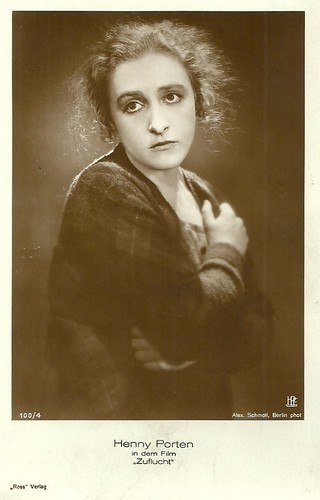
German postcard by Ross Verlag, no. 110/4. Photo: Alex. Schmoll, Berlin / HPF (Henny Porten-Froelich Produktion GmbH (Berlin)). Henny Porten in Zuflucht/Refuge (Carl Froelich, 1928).
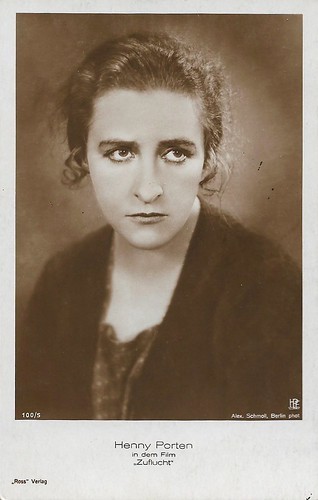
German postcard by Ross Verlag, no. 110/5. Photo: Alex. Schmoll, Berlin / HPF (Henny Porten-Froelich Produktion GmbH (Berlin)). Henny Porten in Zuflucht/Refuge (Carl Froelich, 1928).
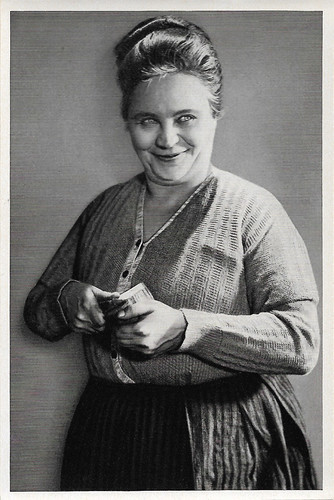
German collectors card by Ross Verlag in the series Vom Werden deutscher Filmkunst - Der Stumme Film, picture no. 198, group 43. Photo: HPF (Henny Porten-Froelich Produktion GmbH (Berlin)). Publicity still for Zuflucht/Refuge (Carl Froelich, 1928).
German actress Margarete Kupfer (1881-1953) was an extremely versatile and prolific character player in classic silent films directed by Friedrich Wilhelm Murnau, Paul Leni and Ernst Lubitsch .
Sources: Hal Erickson (AllMovie), Wikipedia (German) and IMDb.

German postcard by Ross Verlag, no. 100/1. Photo: Alex. Schmoll / HPF (Henny Porten-Froelich Produktion GmbH (Berlin)). Henny Porten and Franz Lederer in Zufluch/tRefuge (Carl Froelich, 1928).

German postcard by Ross Verlag, no. 100/2. Photo: Alex. Schmoll / HPF (HPF (Henny Porten-Froelich Produktion GmbH (Berlin)). Henny Porten and Franz Lederer in Zuflucht/Refuge (Carl Froelich, 1928).

German postcard by Ross Verlag, no. 110/3. Photo: Alex. Schmoll, Berlin / HPF (Henny Porten-Froelich Produktion GmbH (Berlin)). Henny Porten in Zuflucht/Refuge (Carl Froelich, 1928).
A ray of hope
In Zuflucht/Refuge, Franz Lederer plays Martin, who has to flee Germany because of his involvement in the November Revolution. Eight years later, he returns to Berlin. The market vendor Hannelore ( Henny Porten ) offers him shelter in her apartment, whereupon both fall in love. Martin soon finds work in the construction of the north-south subway through the Tempelhof field, but collapses one day. The pregnant Hannelore cares for the seriously ill Martin.
Hal Erickson writes at AllMovie : "Best known for her comedy roles, Henny Porten went dramatic big-time in her 1928 vehicle Zufflucht [sic] (Refuge). Since Porten also produced the film, she bore the brunt of the criticism, which was far from kind. Many felt that the actress would have been better off sticking to comedy, while others were of the opinion that she was too old for her role (she was all of 40 at the time). The most positive comments were reserved for Porten's incredibly good-looking leading man, Francis Lederer . In fact, Zufflucht represented Lederer's screen debut, a full year before his 'official' cinematic bow in Pabst's Pandora's Box."
However, the film was positively received by some of the German critics at the time. The Berliner Lokal-Anzeiger reviewed the film on 1 September 1928: "The fact is that this simple story became a wonderful film, and indeed a tangible step forward in the field of German film in general - thanks not only to the exquisite portrayal, but above all to the direction of the film. Carl Froelich has had the courage to openly show what he has learned from the New Russian film art. [...]
There is hardly any tradition here, there is no bashful make-up, nothing and nobody is made 'cute' - yes, the outstanding Henny Porten does not even shy away from turning into a self-denying Cinderella. That sounds hard, but it means liberation from the traditional teasing fuss of numerous film divas, numerous directors. [...] The film is a ray of hope. "
Critic Hanns Horkheimer added in Berliner Tageblatt on 2 September 1928: "The good role of her Hanne is raised to all-human validity, when this joyless market maid awakens to motherly-loving sacrifice, when she, the tormented, with two powerful arms, makes a new life for the strayed, and then when the short spring is full of warmth and heat Promise on the deathbed of the selfless lover forever vanishes. This lover is Franz Lederer , [...] as a film debutant of the antics of Russian film actors. Naturalistic life and experience are raised by him through creative skill into that sphere in which there are no bravura details, but only a self-evident whole. The management of the again tactically, technically and figuratively very hard-working and skillful Carl Froelich contributed the rest to the success."

German postcard by Ross Verlag, no. 110/4. Photo: Alex. Schmoll, Berlin / HPF (Henny Porten-Froelich Produktion GmbH (Berlin)). Henny Porten in Zuflucht/Refuge (Carl Froelich, 1928).

German postcard by Ross Verlag, no. 110/5. Photo: Alex. Schmoll, Berlin / HPF (Henny Porten-Froelich Produktion GmbH (Berlin)). Henny Porten in Zuflucht/Refuge (Carl Froelich, 1928).

German collectors card by Ross Verlag in the series Vom Werden deutscher Filmkunst - Der Stumme Film, picture no. 198, group 43. Photo: HPF (Henny Porten-Froelich Produktion GmbH (Berlin)). Publicity still for Zuflucht/Refuge (Carl Froelich, 1928).
German actress Margarete Kupfer (1881-1953) was an extremely versatile and prolific character player in classic silent films directed by Friedrich Wilhelm Murnau, Paul Leni and Ernst Lubitsch .
Sources: Hal Erickson (AllMovie), Wikipedia (German) and IMDb.
Published on December 02, 2019 22:00
Paul van Yperen's Blog
- Paul van Yperen's profile
- 13 followers
Paul van Yperen isn't a Goodreads Author
(yet),
but they
do have a blog,
so here are some recent posts imported from
their feed.



